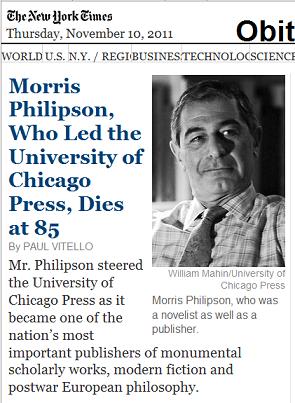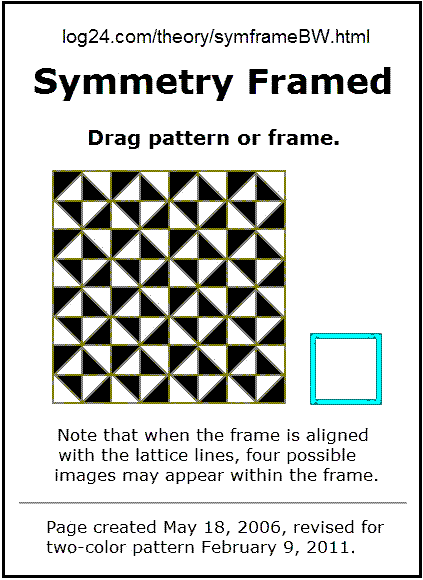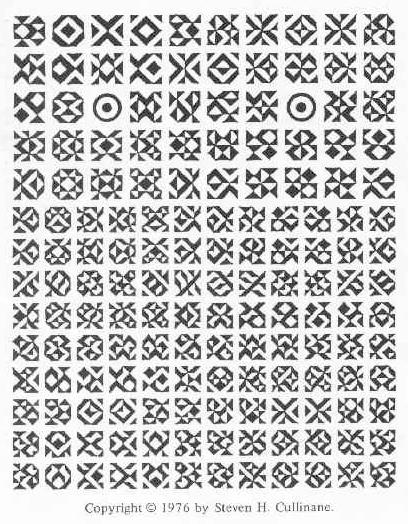See Borsalino, Miller's Crossing, and Road to Perdition.
Sunday, August 18, 2024
Thursday, March 21, 2024
Library Note: Chicago Exposition
|
"Chang noted that 'the story starts slowly, for
1. Chang, Margaret A. "The King in the Window". |
Some will prefer exposition more closely related to Chicago.
From a Log24 search for that word . . .
The above phrase "the intersection of storytelling and visual arts"
suggests a review . . .

Some exposition that does not go back thousands of years —
Wednesday, October 25, 2023
For Judy Chicago, Née Cohen
From the University of Chicago Press…

The Nutshell:

Related Narrative:
………………………………………………………………………………………………………..
Saturday, July 3, 2021
Here, There, and Chicago
The above phrase "the intersection of storytelling and visual arts"
suggests a review . . .
Storytelling —

Visual arts —

"This pattern is a square divided into nine equal parts.
It has been called the 'Holy Field' division and
was used throughout Chinese history for many
different purposes, most of which were connected
with things religious, political, or philosophical."
– The Magic Square: Cities in Ancient China,
by Alfred Schinz, Edition Axel Menges, 1996, p. 71
A Midrash for Michener —

For a connection of the above "Holy Field"
with pure mathematics, see Coxeter's Aleph.
Sunday, April 3, 2011
On to Chicago!
Commentary on last night—

Tonight: The After-Party.
In related news…

"The yarns of seamen have a direct simplicity, the whole meaning of which
lies within the shell of a cracked nut. But Marlow was not typical
(if his propensity to spin yarns be excepted), and to him the meaning
of an episode was not inside like a kernel but outside, enveloping the tale
which brought it out only as a glow brings out a haze, in the likeness of
one of these misty halos that sometimes are made visible by
the spectral illumination of moonshine."
– Joseph Conrad in Heart of Darkness , quoted here in
Cold Open (Saturday night, January 29, 2011)
Saturday, May 25, 2024
Coloring Books*
* Related remarks: Willard Motley on a Chicago color.
Wednesday, November 22, 2023
Home for Thanksgiving
509 Fourth Avenue, Warren, Pennsylvania —

Related material —

Friday, October 20, 2023
Wednesday, June 7, 2023
Exploring Color Space . . . Continues.

"Another story" —
See also Sontag's own account of the Mann meeting.
Related material —

It would seem that Moser is deeply confused about two different
meetings of Sontag with Mann — discussing Doctor Faustus
in 1947, and, later, as a U. of Chicago student, discussing
The Magic Mountain with Mann in 1949 on the Feast of the
Holy Innocents — coincidentally, also the date of her dies natalis
(in the Catholic sense) in 2004.
Thursday, May 18, 2023
The Grave Dancer
CHICAGO–(BUSINESS WIRE) — It is with profound sadness
that Equity Residential (NYSE: EQR) mourns the death of its
Founder and Chairman, Samuel Zell, who died today at age 81.
|
By Allison Morrow, CNN Updated 12:38 PM EDT, Thu May 18, 2023 Sam Zell, the Chicago real-estate magnate whose knack for buying up distressed assets turned him into a billionaire and earned him the nickname “grave dancer,” died on Thursday, his company said. He was 81. Equity Residential, the company he founded decades ago, did not provide a cause of death but described Zell as an “iconic figure in real estate and throughout the corporate world.” Among his wide-ranging portfolio of investments were distressed assets in real estate and in media, including an ultimately disastrous bet on the Tribune Company. Zell had a personal net worth of $5.9 billion, according to the Bloomberg Billionaires Index. Zell had a penchant for scooping up cheap real estate and selling it later at a profit, a strategy he outlined in a 1978 article titled “The Grave Dancer,” which became his nickname in the industry. “I was dancing on the skeletons of other people’s mistakes,” he wrote. |
Sunday, February 5, 2023
Dimensions

A Logo for Riri —

The above Nick Romano passage is from Knock on Any Door,
a 1947 novel by Willard Motley. Another Motley novel about
Chicago, from 1958 . . .
|
Page 41 The city was a blue-black panther that slunk along beside them. The tall, skyscraper night-grass hemmed them in. The thousand neon animal eyes watched their going. Page 67 The blue-black panther of a city watched their going. The un- blinking neon animal eyes watched their going. Thousands of neon signs lit their way. In an alley behind West Madison Street half an Page 68 hour before, a bum, drunk, had frozen to death lying in the back doorway of a pawnshop. The blue-black panther crouched over him. Page 70 First the creak of ice as an automobile goes by. Then the frown into your room of the red brick building across the street, its windows frosted over like cold, unfriendly eyes. Then a bum stumbling along trying to keep warm. Now a drunk, unevenly. And the wind like the howling voice of the blue-black panther, hunting, finding. And the clanging of impersonal streetcars. And each bar of neon, cold, dead. No message. The clown takes his bow and it is Christmas Day. Page 79 The blue-black panther followed them, sniffing at their heels. Page 106 Above them the blue-black panther lay on the roof of a tenement house, its feline chin on the cornice, its yellow-green eyes staring down onto the black night street of Maxwell. Its tail, wagging slowly back and forth, was like a lasso, a noose, sending little shivers of pebbles rolling loosely across the roof. Page 154 Then he went down to the Shillelagh Club. Through the pane, in the crowded, noisy place, he saw her. She was sitting at a table near the back, alone. Her cigarette had fallen from her lips and rolled away from her on the table top. It had burned itself to a long gray ash. Her head hung loosely on her neck as if she was asleep. A half-empty glass of beer was in front of her. Please, Mother, please come out, he prayed to her. And he stood next door to the tavern, waiting, his small shoulders drawn in, his head down in shame. And often he walked to the window and stood on tiptoe. She was still there. In the same position. He waited. He would be late to school tomorrow. He waited, keeping the long vigil. He waited. Twelve years old. And the thousand neon-animal eyes stared at him savagely. He waited. The blue-black panther lashed out its tail, flicking its furry tip against his ankles. He waited. Page 250 Alongside the blue-black patrol wagon the blue-black panther walks majestically. Page 262 Outside the door the blue-black panther rubs its back like a house cat. Page 409 Nick held the cigarette listlessly. The smoke curled up his wrist and arm like a snake. The blue-black panther licked his hand. |
Monday, October 3, 2022
Old Code
In memory of a mathematics professor who
reportedly died on May 21, 2022 —
"… mouses over to a file …." Or a folder.

Saturday, July 30, 2022
Modal Diamond Box
|
A mnemonic from a course titled
“Traditionally, there are two modalities, namely,
|
For less rigorous remarks, search Log24 for Modal Diamond Box.
Friday, June 3, 2022
Christian at Chapman
INTERNATIONAL CONFERENCE:
GROTHENDIECK, A MULTIFARIOUS GIANT:
MATHEMATICS, LOGIC AND PHILOSOPHY
CHAPMAN UNIVERSITY, ORANGE (CA)
— BECKMAN HALL, ROOM 106 MAY 24TH-28TH, 2022 . . .
|
27th Friday
4:30 – 5:30 Christian Houzel (IUFM de Paris): |
Related reading for enthusiasts of the Black Arts —
Saturday, February 12, 2022
Das Geheimnis der Einheit
Thomas Mann on "the mystery of the unity" —

"Denn um zu wiederholen, was ich anfangs sagte:
in dem Geheimnis der Einheit von Ich und Welt,
Sein und Geschehen, in der Durchschauung des
scheinbar Objectiven und Akzidentellen als
Veranstaltung der Seele glaube ich den innersten Kern
der analytischen Lehre zu erkennen." (GW IX 488)
An Einheit-Geheimnis that is perhaps* more closely related
to pure mathematics** —
"What is the nature of the original unity
that throws itself apart in this separation,
and in what sense are the separated ones
here as the essence of the abyss?
Here it cannot be a question of any kind of 'dialectic,'
but only of the essence of the ground
(that is, of truth) itself." [Tr. by Google]
" Welcher Art ist die ursprüngliche Einheit,
daß sie sich in diese Scheidung auseinanderwirft,
und in welchem Sinn sind die Geschiedenen
hier als Wesung der Ab-gründigkeit gerade einig?
Hier kann es sich nicht um irgend eine »Dialektik«
handeln, sondern nur um die Wesung des Grundes
(der Wahrheit also) selbst."
* Or perhaps not .
** For a relevant Scheidung , see Eightfold Cube.
Monday, January 31, 2022
The Prime Mover
"Metaphor in language — the prime mover"
— George Steiner in Real Presences (1989)
Not so prime —
See also the "Transformers" marketing saga.
Related marketing:
Disney Easter eggs —
Friday, July 16, 2021
Mystical Mathematicks
The title is from Sir Thomas Browne:
"To enlarge this contemplation unto all the mysteries and secrets,
accomodable unto this number, were inexcusable Pythagorisme,
yet cannot omit the ancient conceit of five surnamed the number
of justice; as justly dividing between the digits, and hanging in
the centre of Nine . . . ."
"Separately." — Ben Franklin
Saturday, June 26, 2021
Critical Space Theory: The Three Stooges at Harvard
Monday, August 3, 2020
Liquor Tale
From an obituary in today’s Boston Globe —
“His father, meanwhile, had retired and hoped
to open a liquor store in Brooklyn.
When bureaucratic hurdles made his goal seem unreachable,
an old friend, Anthony Paterno, who ran a grocery and bottling
business in Chicago, persuaded him to try opening a shop there,
where fewer obstacles existed.
Salvatore Terlato enlisted Anthony to help him, and together
they opened the shop, Leading Liquor Marts, in 1955.”
See also Sunset Boulevard Revisited and . . .

“Do not block intersection.” — City of Los Angeles
Saturday, May 2, 2020
Tuesday, February 18, 2020
For Rose the Hat
New Spaces: The Ninth Gate
"Nothing opens up new spaces…."
— Book description from the University of Chicago Press,
shown here on February Ninth, 2020:
See as well the Roman Polanski film "The Ninth Gate" and
an obituary reporting a death on February Ninth.
"… while at the end I didn't yearn for spectacular special effects,
I did wish for spectacular information–something awesome,
not just a fade to white." — Roger Ebert, March 10, 2000
Sunday, February 9, 2020
Hors d’Oeuvre
From the May Day 2016 link above, in "Sunday Appetizer from 1984" —
The 2015 German edition of Beautiful Mathematics , a 2011 Mathematical Association of America (MAA) book, was retitled Mathematische Appetithäppchen — Mathematical Appetizers . The German edition mentions the author's source, omitted in the original American edition, for his section 5.17, "A Group of Operations" (in German, 5.17, "Eine Gruppe von Operationen")—
That source was a document that has been on the Web since 2002. The document was submitted to the MAA in 1984 but was rejected. The German edition omits the document's title, and describes it as merely a source for "further information on this subject area." |
From the Gap Dance link above, in "Reading for Devil's Night" —
“Das Nichts nichtet.” — Martin Heidegger.
And "Appropriation Appropriates."
Sunday, January 12, 2020
Fragments
From this journal on June 25, 2009 —
“… T. S. Eliot tried to recompose, in Four Quartets,
the fragments he had grieved over in The Waste Land.”
— “Beauty and Desecration,” Roger Scruton
From The Guardian today —
From this journal this morning —
“The spatial conception interconnects the meaning fragments
and binds them together . . . .“
— S. Giedion, introduction to Language of Vision by Gyorgy Kepes
Cross of the Stations
From the previous post —
"… a single station point for naturalistic representation."
— S. Giedion, introduction to Language of Vision by Gyorgy Kepes
Cf. The Last Station, not The Finland Station.
Plastic Elements
"Step by step, Kepes follows the liberation of the plastic elements:
lines, planes, and colors, and the creation of a world of forms of our own.
The spatial conception interconnects the meaning fragments and
binds them together just as in another period perspective did when it used
a single station point for naturalistic representation."
— S. Giedion, introduction to Language of Vision by Gyorgy Kepes
Tuesday, December 24, 2019
Lucy Noir …
… Continued from August 26 —

Heidegger, "Hölderlin and the Essence of Poetry,"
translated by Douglas Scott, in Existence and Being ,
Regnery, 1949, pp. 291-316—

See as well Readings for St. Patrick's Day, March 17, 2005.
Tuesday, August 13, 2019
Putting the Structure in Structuralism
(From his “Structure and Form: Reflections on a Work by Vladimir Propp.”
Translated from a 1960 work in French. It appeared in English as
Chapter VIII of Structural Anthropology, Volume 2 (U. of Chicago Press, 1976).
Chapter VIII was originally published in Cahiers de l’Institut de Science
Économique Appliquée , No. 9 (Series M, No. 7) (Paris: ISEA, March 1960).)

The structure of the matrix of Lévi-Strauss —
Illustration from Diamond Theory , by Steven H. Cullinane (1976).
The relevant field of mathematics is not Boolean algebra, but rather
Galois geometry.
Tuesday, June 4, 2019
Zen and the Art
Or: Burning Bright
A post in memory of Chicago architect Stanley Tigerman,
who reportedly died at 88 on Monday.
Tuesday, May 14, 2019
The Nothing That Is
Philosophy professor Agnes Callard on giving advice:
"It’s as though right before I give the advice,
I push a button that sucks all the informational
content out of what I’m about to say, and
I end up saying basically nothing at all."
— https://thepointmag.com/2019/
examined-life/against-advice-agnes-callard
From a University of Chicago description of Callard —

See as well posts before and after the above date, Jan. 3, 2018,
that are now tagged "Lost Horizon."
More generally, see a Log24 search for "Lost Horizon."
Monday, March 25, 2019
Wednesday, October 24, 2018
Ay Que Bonito
"Ay que bonito es bailar
a las dos de la mañana"
— Adapted from a song lyric
See also . . .
Shadi Bartsch-Zimmer, Helen A. Regenstein
Distinguished Service Professor of Classics
at the University of Chicago,
"currently the lead editor of the journal
KNOW: A Journal on the Formation of Knowledge."
Wednesday, October 3, 2018
Nobel Literature Prize
The New York Times today —
Leon Lederman, 96, Explorer (and Explainer) of
the Subatomic World, Dies
By George Johnson
Oct. 3, 2018
Leon Lederman, whose ingenious experiments with particle accelerators
deepened science’s understanding of the subatomic world, died
early Wednesday in Rexburg, Idaho. He was 96.
His wife, Ellen Carr Lederman, confirmed the death, at a care facility.
She and Dr. Lederman, who had long directed the Fermi National Accelerator
Laboratory outside Chicago, had retired to eastern Idaho.

"… novelist, poet and minister George MacDonald . . . ."
See as well Jess Lederman, Investment Banker.
"I have three children with my first wife, Florence Gordon.
Daughter Rena is an anthropologist,
son Jesse is an investment banker
and daughter Rachel a lawyer."
— Leon Lederman at nobelprize.org.
Tuesday, June 26, 2018
Rock Notes
"Vinnie Paul of the band Hellyeah performs in concert
during Day 2 of the Rock Allegiance Festival at
Talen Energy Stadium on Sunday, Sept. 18, 2016, in
Chester, Pa. (Photo by Owen Sweeney/Invision/AP)"
"Former SKID ROW singer Sebastian Bach played
a cover version of the PANTERA classic
"Cemetery Gates" as a tribute to Vinnie Paul Abbott
during his June 24 concert at The Pyramid Cabaret in
Winnipeg, Manitoba, Canada."
Thursday, November 23, 2017
Lévi-Strauss vs. Propp
| Claude Lévi-Strauss
From his “Structure and Form: To maintain. as I have done. that the permutability of contents is not arbitrary amounts to saying that, if the analysis is carried to a sufficiently deep level, behind diversity we will discover constancy. And, of course. the avowed constancy of form must not hide from us that functions are also permutable. The structure of the folktale as it is illustrated by Propp presents a chronological succession of qualitatively distinct functions. each constituting an independent genre. One can wonder whether—as with dramatis personae and their attributes— Propp does not stop too soon, seeking the form too close to the level of empirical observation. Among the thirty-one functions that he distinguishes, several are reducible to the same function reappearing at different moments of the narrative but after undergoing one or a number of transformations . I have already suggested that this could be true of the false hero (a transformation of the villain), of assigning a difficult task (a transformation of the test), etc. (see p. 181 above), and that in this case the two parties constituting the fundamental tale would themselves be transformations of each other. Nothing prevents pushing this reduction even further and analyzing each separate partie into a small number of recurrent functions, so that several of Propp’s functions would constitute groups of transformations of one and the same function. We could treat the “violation” as the reverse of the “prohibition” and the latter as a negative transformation of the “injunction.” The “departure” of the hero and his “return” would appear as the negative and positive expressions of the same disjunctive function. The “quest” of the hero (hero pursues someone or something) would become the opposite of “pursuit” (hero is pursued by something or someone), etc.
In Vol. I of Structural Anthropology , p. 209, I have shown that this analysis alone can account for the double aspect of time representation in all mythical systems: the narrative is both “in time” (it consists of a succession of events) and “beyond” (its value is permanent). With regard to Propp’s theories my analysis offers another advantage: I can reconcile much better than Propp himself his principle of a permanent order of wondertale elements with the fact that certain functions or groups of functions are shifted from one tale to the next (pp. 97-98. p. 108) If my view is accepted, the chronological succession will come to be absorbed into an atemporal matrix structure whose form is indeed constant. The shifting of functions is then no more than a mode of permutation (by vertical columns or fractions of columns). These critical remarks are certainly valid for the method used by Propp and for his conclusions. However. it cannot be stressed enough that Propp envisioned them and in several places formulated with perfect clarity the solutions I have just suggested. Let us take up again from this viewpoint the two essential themes of our discussion: constancy of the content (in spite of its permutability) and permutability of functions (in spite of their constancy). * Translated from a 1960 work in French. It appeared in English as Chapter VIII |
See also “Lévi-Strauss” + Formula in this journal.
Some background related to the previous post —

Wednesday, November 22, 2017
Goethe on All Souls’ Day
David E. Wellbery on Goethe
From an interview published on 2 November 2017 at
http://literaturwissenschaft-berlin.de/interview-with-david-wellbery/
as later republished in

The logo at left above is that of The Point .
The menu icon at right above is perhaps better
suited to illustrate Verwandlungslehre .
Friday, July 28, 2017
Compare and Contrast
From an obituary in this afternoon's online New York Times —
"Mr. Morris published his autobiography,
Get the Picture: A Personal History of Photojournalism , in 1998."
The obit suggests a review of posts mentioning the film
"The Secret Life of Walter Mitty," starring Kristen Wiig.
See as well Wiig and the Louvre Banquet Hall in L.A. —
The book title Get the Picture above suggests a review of
a different Louvre picture, starring Audrey Hepburn —
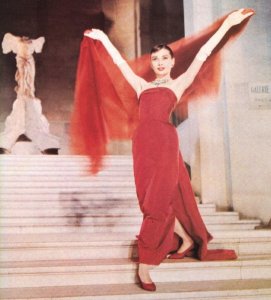
Tuesday, May 16, 2017
For Westworld’s Man in Black
From University of Chicago Press in 1984:
"Drawing on Hegel, Nietzsche, Derrida,
and others, Mark Taylor extends—and
goes well beyond—pioneering efforts. . . . "
—G. Douglas Atkins,
Philosophy and Literature
Update at noon on May 16 —
"Follow the Blood Arroyo to the place
where the snake lays its eggs."
— Westworld, Season 1, Episode 2,
air date October 9, 2016
This suggests a review of Derrida + Serpent
in this journal.
Wednesday, April 26, 2017
About
From a post of March 16, 2017 —
"Bulk apperception" is defined in the Westworld script
as "basically, overall intelligence." The phrase is apparently
unique to Westworld.
These two words do, however, nearly occur together
in at least one book — Andrew Feffer's The Chicago
Pragmatists and American Progressivism :

Tuesday, March 21, 2017
Requiescat in Pace
The Chicago Tribune today —
H. Wilbert Norton, college president
and Christian missionary, dies
Norton reportedly died at 102 on Feb. 20, 2017.
This evening's previous post linked the death dates of two
academics to two Log24 posts that both contained the
following image —
For some backstory, see the Log24 posts from the date
of Norton's reported death, February 20.
Thursday, March 16, 2017
“Bulk Apperception”
"By groping toward the light we are made to realize
how deep the darkness is around us."
— Arthur Koestler, The Call Girls: A Tragi-Comedy ,
Random House, 1973, page 118
"Dear boys — We’re going to have some fun, aren’t we?"
— Maeve in "Westworld," Season 1, Episode 6,
after her "bulk apperception" has been upgraded
to the maximum.
"Bulk apperception" is defined in the script as "basically,
overall intelligence." The phrase is apparently unique to "Westworld."
These two words do, however, nearly occur together in
at least one book — Andrew Feffer's The Chicago Pragmatists
and American Progressivism :

Iacta Est
"Though realism is excellent rhetoric, maybe the best,
in a purely technical or instrumental sense,
that cannot be an adequate reason to accept it
as a serious intellectual position. In its tropes of
Death and Furniture we see a rhetoric that refuses
to acknowledge its own existence; a politics that
can claim a critical-radical credibility only by
the selective use of its opponents' analytic tools;
and a theology which is deeply conservative and
seeks nothing less than the death of disruptive,
disturbing inquiry. While tedium, good taste, political
and moral sensibility will properly determine what
sorts of given realities are thought worthy of inquiry,
those considerations are no grounds for promoting
a realist ontology for social science, nor any other
science, nor for rejecting relativism. On the contrary,
relativism is social science par excellence . . . ."
Loughborough University
— Edwards, D., Ashmore, M., and Potter, J. (1995),
"Death and furniture: The rhetoric, politics and theology
of bottom line arguments against relativism,"
History of the Human Sciences , 8, 25-49.
Related material:
Platonic realism in this journal, yesterday's post Ripples, and …
Gravity's Shadow , 2004 —
Gravity's Ghost , 2010 —
See also an "Inception"-related object —
Wednesday, January 4, 2017
Sunday, December 11, 2016
Complexity to Simplicity
Cézanne "showed how it was possible to pass
from the complexity of the appearance of things
to the geometrical simplicity which design demands."
— Roger Fry in the catalogue for the 1910 London
exhibition "Manet and the Post-Impressionists,"
according to …
See also A Roger Fry Reader
(edited by Christopher Reed,
University of Chicago Press, 1996).
Monday, October 31, 2016
Sunday, October 30, 2016
Saturday, September 3, 2016
CP is for Consolation Prize
CERN COURIER May 28, 1999:
In hot pursuit of CP violation
"CP was a consolation prize for physicists.
At least it seemed so until 1964."
"James W. Cronin, who shared the Nobel Prize in physics
for discovering a startling breakdown in what was assumed
to be the immutable symmetry of physical law, thereby
helping to explain the behavior and evolution of the universe
as a whole, died Aug. 25 in St. Paul, Minn. He was 84.
Dr. Cronin’s death was announced by the University of Chicago,
where he was a professor emeritus of physics as well as of
astronomy and astrophysics. No cause was reported."
— Martin Weil in The Washington Post , August 28, 2016
CP is for Consolation Prize
CERN COURIER May 28, 1999:
In hot pursuit of CP violation
"CP was a consolation prize for physicists.
At least it seemed so until 1964."
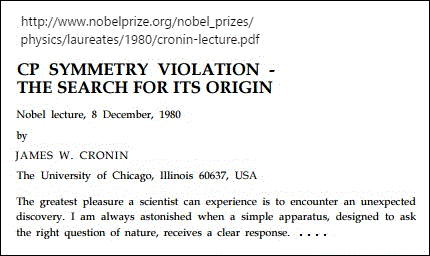
"James W. Cronin, who shared the Nobel Prize in physics
for discovering a startling breakdown in what was assumed
to be the immutable symmetry of physical law, thereby
helping to explain the behavior and evolution of the universe
as a whole, died Aug. 25 in St. Paul, Minn. He was 84.
Dr. Cronin’s death was announced by the University of Chicago,
where he was a professor emeritus of physics as well as of
astronomy and astrophysics. No cause was reported."
— Martin Weil in The Washington Post , August 28, 2016
Tuesday, August 9, 2016
Snowflake
Tuesday, June 28, 2016
“Use ‘The Source,’ Luke”
See Source + Michener and The Source (Dec. 29, 2014).
Saturday, June 25, 2016
ART WARS: The Story of Four
The title is a reference to the Chicago character named "Four"
in Veronica Roth's Divergent series.
"In July 2014, Roth revealed that she initially wrote
Divergent from Four's point of view . . . ." — Wikipedia
Other Chicago-related stories — "Raiders of the Lost Code"
(on the recent murder-suicide of two Chicago Jungians)
and the following —
See also Jungian narrative art in
https://redice.tv/news/
on-the-nature-of-four-jung-s-quarternity-mandalas-the-stone-and-the-self .
Wednesday, June 22, 2016
Tutelary Figures
(Continued from December 19, 2007)
http://chicago.suntimes.com/news/
colleagues-shocked-as-noted-psychologists-die-in-murder-suicide/
Another tutelary figure —
Friday, March 18, 2016
Weimar, Baby!*
Happy birthday to composer John Kander, who turns 89 today.
NPR MUSIC INTERVIEWS
|
* See Noonan Weimar in this journal.
Sunday, November 1, 2015
Transitions
Two transitions from last Monday, Oct. 26, 2015,
according to the online New York Times today —
|
Leo P. Kadanoff, a physicist who provided critical insights into the transformations of matter from one state to another, died last Monday in Chicago. He was 78. The cause was respiratory failure, said the University of Chicago, where he was a professor from 1978 until his retirement in 2003. A member of the National Academy of Sciences and a fellow of the American Academy of Arts and Sciences, he received the National Medal of Science in 1999. “He won basically every prize except the Nobel Prize, and many people thought he should have won the Nobel,” said Emil Martinec, a physics professor at the University of Chicago who directs the university’s Kadanoff Center for Theoretical Physics. Dr. Kadanoff’s biggest scientific contribution came in the 1960s as scientists were trying to understand phase transitions, when matter changes from one form to another. A Cornell chemist, Benjamin Widom, had come up with mathematical relationships that described behavior associated with second-order phase transitions, which include the boiling of water to steam at a particular temperature and pressure. But Dr. Widom did not have an underlying physical explanation for why these relationships existed. |
Willis Carto, a reclusive behind-the-scenes wizard of the far-right fringe of American politics who used lobbying and publishing to denigrate Jews and other minorities and galvanize the movement to deny the Holocaust, died last Monday at his home in Virginia. He was 89. His death was announced by The American Free Press, a newspaper he helped found. Mr. Carto raised funds to finance a right-wing military dictatorship in the United States, campaigned to persuade blacks to voluntarily return to Africa and, most influentially, started newsletters, a journal and conferences of academics and others to deny the scale, and even the existence, of the Holocaust. The Anti-Defamation League called him “one of the most influential American anti-Semitic propagandists” and “the mastermind of the hate network.” His associates included neo-Nazis, Christian vigilantes, John Birch Society members and Ku Klux Klansmen, and his extreme views alienated mainstream conservatives. After William F. Buckley sued Mr. Carto for libel and won in 1985, Mr. Buckley said Mr. Carto epitomized “the fever swamps of the crazed right.’’ |
Related remarks:
Posts tagged "Steam," the post "On Ice-Breaking" from Oct. 27,
the post "Expanding the Seagram Spielraum" from Oct. 26, and
a 2008 article on the subject of the obituary at right above.
Tuesday, December 30, 2014
An Education
AP Today in History
Thought for the Day:
“I respect faith, but doubt is what
gives you an education.”
— Wilson Mizner,
American playwright (1876-1933)*
From this journal on the (wide) release date
of "X-Men: First Class" —
A minimalist 3×3 matrix favicon—
This may, if one likes, be viewed as the "nothing"
present at the Creation. See Jim Holt on physics.
* A source —
Saturday, August 2, 2014
Smart Art
Horwich reportedly died on July 21, 2014.
For a different perspective on smart art, see the Log24 posts of April 2013.
Tuesday, July 8, 2014
Toward Freedom
A search for "Dark Fields of the Republic,"
an F. Scott Fitzgerald phrase mentioned in
the previous post, yields a book by that title.
"When does a life bend toward freedom?
grasp its direction?"
— Adrienne Rich on page 275 of
Later Poems Selected and New: 1971-2012
The book's author, Adrienne Rich, died at 82 on
March 27, 2012. See that date in this journal.
See also the following:
|
The Diamond Cutters by Adrienne Rich (1955)
However legendary,
Now, you intelligence
Be serious, because
Be hard of heart, because
Be proud, when you have set |
Saturday, July 5, 2014
Core Curriculum
This post was suggested by reviews of the David Hare play “Skylight” at
The New York Times , at WorldSocialism.org, and at ChicagoCritic.com.
Vide Atoms in the Family , by Laura Fermi, a book I read in high school.
Saturday, May 31, 2014
For the Black Widow Club*
… and for Anthony Hopkins and a Black Widow,
as well as for a filmmaker who reportedly died on May 19.


Update of 4:48 PM ET: See also Philip Roth on an ambiguity.
* The title was suggested in part by a series of Isaac Asimov mysteries.
Monday, March 31, 2014
For Women’s History Month
“…what he was trying to get across was not that he was the Soldier of a Power that was fighting across all of time to change history, but simply that we men were creatures with imaginations and it was our highest duty to try to tell what it was really like to live in other times and places and bodies. Once he said to me, ‘The growth of consciousness is everything… the seed of awareness sending its roots across space and time. But it can grow in so many ways, spinning its web from mind to mind like the spider or burrowing into the unconscious darkness like the snake. The biggest wars are the wars of thought.'”
— Fritz Leiber, “The Oldest Soldier” (1960)
“And that’s the snake.” — Jill Clayburgh in “It’s My Turn” (1980)
Backstory — “For Daedalus,” May 26, 2009.
For a more up-to-date look at Burroway, see a
Chicago Tribune story of March 21, 2014.
Monday, February 24, 2014
Second City
See Stadium Devildare, Church Notes, and Ruth Margraff*.
Ruthless : A Brief Drama —
"There is no ____ , there is only Zuul."
— Adapted from Ghostbusters
* In a webpage dated July 25, 2007.
See also this journal on that date.
Dr. Spengler’s Experiment
Tuesday, November 5, 2013
Wednesday, June 19, 2013
Tuesday, May 7, 2013
Outrageous Fantasy
Or: Ready When You Are, C. B.
Dennis McLellan, Special to The Los Angeles Times , May 7, 2013:
Born in Los Angeles on June 29, 1920, Harryhausen was 13
when he saw "King Kong" during its run at Grauman's Chinese
Theater in Hollywood.
"I haven't been the same since," he is repeatedly quoted
as saying over the years.
"I came out of the theater awestruck," Harryhausen elaborated
in a 1999 interview with the Chicago Tribune. "It was such a
totally different, unusual film. The story line led you from the
mundane world into the most outrageous fantasy that's ever
been put on the screen."
Sunday, April 28, 2013
The Octad Generator
… And the history of geometry —
Desargues, Pascal, Brianchon and Galois
in the light of complete n-points in space.
(Rewritten for clarity at about 10 AM ET April 29, with quote from Dowling added.
Updated with a reference to a Veblen and Young exercise (on p. 53) on April 30.)
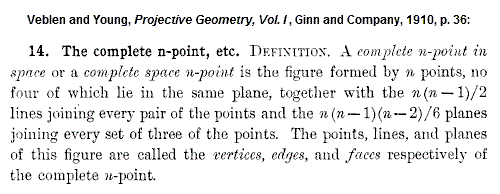

Veblen and Young, Projective Geometry, Vol. I ,
Ginn and Company, 1910, page 39:
"The Desargues configuration. A very important configuration
is obtained by taking the plane section of a complete space five-point."

Each of figures 14 and 15 above has 15 points and 20 lines.
The Desargues configuration within each figure is denoted by
10 white points and 10 solid lines, with 3 points on each line and
3 lines on each point. Black points and dashed lines indicate the
complete space five-point and lines connecting it to the plane section
containing the Desargues configuration.
In a 1915 University of Chicago doctoral thesis, Archibald Henderson
used a complete space six -point to construct a configuration of
15 points and 20 lines in the context not of Desargues ' theorem, but
rather of Brianchon 's theorem and of the Pascal hexagram.
Henderson's 1915 configuration is, it turns out, isomorphic to that of
the 15 points and 20 lines in the configuration constructed via a
complete space five -point five years earlier by Veblen and Young.
(See, in Veblen and Young's 1910 Vol. I, exercise 11, page 53:
"A plane section of a 6-point in space can be considered as
3 triangles perspective in pairs from 3 collinear points with
corresponding sides meeting in 3 collinear points." This is the
large Desargues configuration. See Classical Geometry in Light of
Galois Geometry.)
For this large Desargues configuration see April 19.
For Henderson's complete six –point, see The Six-Set (April 23).
That post ends with figures relating the large Desargues configuration
to the Galois geometry PG(3,2) that underlies the Curtis
Miracle Octad Generator and the large Mathieu group M24 —
See also Note on the MOG Correspondence from April 25, 2013.
That correspondence was also discussed in a note 28 years ago, on this date in 1985.
Wednesday, April 10, 2013
Art Wars (continued)
Thursday, April 4, 2013
Soul of a Poet
"We buy it lock, stock, and shot glass"
— Ebert on Newman's performance in "The Verdict."
Monday, January 28, 2013
PEP Talk
Review: A page linked to here on Jan. 25—
psychoanalyst Heinz Kohut on the "nuclear self"—
The Psychoanalytic Electronic Publishing (PEP) website has a
paper on Kohut's concept— "Nuclear Conflict and the Nuclear Self"—
to which access is restricted:

Perhaps the late Aaron Swartz (below) now has freer access
to this and other restricted reading.

Friday, January 25, 2013
Where Credit Is Due
Harvard's President Faust:
Last evening's post Moondance was suggested by a check
in this journal of the date October 10, 2012. That date was
in turn suggested by the date of the above remarks.
Wer immer strebend sich bemüht,
Den können wir erlösen.
Who always striving efforts makes,
For him there is salvation.
— Faust Part 2, Act V, Scene 7: Mountain Gorges.
Monday, December 17, 2012
Nonlyric Stupidity
Or: Being There
(A sequel to last night's Lyric Intelligence )
William Deresiewicz reviews Kurt Vonnegut's 1952 novel Player Piano :
The novel’s prescience is chilling. Six years before the left-wing English
sociologist Michael Young published The Rise of the Meritocracy ,
a dystopian satire that coined that now-ubiquitous final word,
Vonnegut was already there.
Related material:
Intelligence Test , Gombrich, and, more generally, Stupidity.
Wednesday, November 28, 2012
Sunday, July 22, 2012
Biograph
"One ring to bring them all…"
— J. R. R. Tolkien, Catholic author
Today in History, July 22, by The Associated Press—
"In 1934, bank robber John Dillinger was shot to death
by federal agents outside Chicago's Biograph Theater,
where he had just seen the Clark Gable movie
'Manhattan Melodrama.'"
From a Manhattan Melodrama—
"Follow the Ring"
Piatigorsky died on Sunday, July 15. Notes in this journal from that date—
- A July 15 update within a post of Sunday, July 8, and
- Converse.
Backstory—
Thursday, July 5, 2012
Claves Regni Caelorum
Or: Night of Lunacy
From 9 PM Monday —

Note that the last line, together with the page number, forms
a sort of key—

The rest of the story—

For one reinterpretation of the page number 304, see a link—
Sermon— from Tuesday's post Diamond Speech.
The linked-to sermon itself has a link, based on a rereading
of 304 as 3/04, to a post of March 4, 2004, with…
WW and ZZ
as rendered by figures from the Kaleidoscope Puzzle—
Yesterday morning the same letter-combinations occurred
in a presentation at CERN of a newly discovered particle—
(Click for context.)
Since the particle under discussion may turn out to be the
God particle, it seems fitting to interpret WW and ZZ as part
of an imagined requiem High Mass.
Ron Howard, director of a film about CERN and the God particle,
may regard this imaginary Mass as performed for the late
Andy Griffith, who played Howard's father in a television series.
Others may prefer to regard the imaginary Mass as performed
for the late John E. Brooks, S. J., who served as president of
The College of the Holy Cross, Worcester, Mass., for 24 years.
Griffith died Tuesday. Brooks died Monday.
For some background on the Holy Cross, see posts of
Sept. 14 (Holy Cross Day) and Sept. 15, 2010—
For more lunacy, see…
Continue a search for thirty-three and three
— Katherine Neville, The Eight
Monday, July 2, 2012
Stiftung
Heidegger, "Hölderlin and the Essence of Poetry,"
translated by Douglas Scott, in Existence and Being ,
Regnery, 1949, pp. 291-316—


See also Hexagram 36.
Tuesday, June 26, 2012
Looking Deeply
Last night's post on The Trinity of Max Black and the use of
the term "eightfold" by the Mathematical Sciences Research Institute
at Berkeley suggest a review of an image from Sept. 22, 2011—
The triskele detail above echoes a Buddhist symbol found,
for instance, on the Internet in an ad for meditation supplies—

Related remarks—
http://www.spencerart.ku.edu/about/dialogue/fdpt.shtml—
Mary Dusenbury (Radcliffe '64)—
"… I think a textile, like any work of art, holds a tremendous amount of information— technical, material, historical, social, philosophical— but beyond that, many works of art are very beautiful and they speak to us on many layers— our intellect, our heart, our emotions. I've been going to museums since I was a very small child, thinking about what I saw, and going back to discover new things, to see pieces that spoke very deeply to me, to look at them again, and to find more and more meaning relevant to me in different ways and at different times of my life. …
… I think I would suggest to people that first of all they just look. Linger by pieces they find intriguing and beautiful, and look deeply. Then, if something interests them, we have tried to put a little information around the galleries to give a bit of history, a bit of context, for each piece. But the most important is just to look very deeply."
http://en.wikipedia.org/wiki/Nikaya_Buddhism—
According to Robert Thurman, the term "Nikāya Buddhism" was coined by Professor Masatoshi Nagatomi of Harvard University, as a way to avoid the usage of the term Hinayana.[12] "Nikaya Buddhism" is thus an attempt to find a more neutral way of referring to Buddhists who follow one of the early Buddhist schools, and their practice.
12. The Emptiness That is Compassion:
An Essay on Buddhist Ethics, Robert A. F. Thurman, 1980
[Religious Traditions , Vol. 4 No. 2, Oct.-Nov. 1981, pp. 11-34]
http://dsal.uchicago.edu/cgi-bin/philologic/getobject.pl?c.2:1:6.pali—
Nikāya [Sk. nikāya, ni+kāya]
collection ("body") assemblage, class, group
http://en.wiktionary.org/wiki/नि—
Sanskrit etymology for नि (ni)
1 From Proto-Indo-European *ni …
Prefix
नि (ni)
- down
- back
- in, into
http://www.rigpawiki.org/index.php?title=Kaya—
Kaya (Skt. kāya ; སྐུ་, Tib. ku ; Wyl. sku ) —
the Sanskrit word kaya literally means ‘body’
but can also signify dimension, field or basis.
• structure, existentiality, founding stratum ▷HVG KBEU
Note that The Trinity of Max Black is a picture of a set—
i.e., of an "assemblage, class, group."
Note also the reference above to the word "gestalt."
"Was ist Raum, wie können wir ihn
erfassen und gestalten?"
Saturday, March 31, 2012
The Kick
"The inception of critical thought, of a philosophic anthropology, is contained in the archaic Greek definition of man as a 'language-animal'…."
— George Steiner, Real Presences , U. of Chicago Press, 1991, p. 89 (See also Steiner on Language.)
"To some, Inception is a film about the creative process, specifically filmmaking, with Cobb as the director, Saito the producer, Ariadne the screenwriter, Eames the actor, and so on. To others the entire movie is a dream in that the film supports Carl Jungs' dream analysis; with all of the supporting characters acting as classical archetypes to Cobb's multiple personalities (which would also justify the lack of development in the supporting characters). The fact that Inception , in the few months since its initial release, has already given rise to so much discussion and critical thought is much more revelatory than whether or not Cobb is still dreaming."
— Russell Espinosa at FilmFracture.com, Jan. 1, 2011
See also Piaf's "Rien de Rien " in a Log24 post from Jan. 19, 2012.
Friday, March 30, 2012
Steiner on Language
March 28 review in the Times Literary Supplement of
George Steiner's new book The Poetry of Thought—
"If this new book opens with the concession that
language has neither the performative power of music
nor the elegant precision of mathematics,
it is language, for Steiner, that defines the human.
The survey accordingly begins from the ancient Greek
view of man as the 'language-animal.'"
A check of this phrase yields, in a 1969 Steiner essay,
"The Language Animal," a Greek form of the phrase—
In short, the least inadequate definition we can arrive at
of the genus homo , the definition that fully distinguishes
him from all neighbouring life-forms, is this:
man is a zoon phonanta , a language-animal.
— p. 10 in Encounter , August 1969 (essay on pp. 7-23)
After introducing "language-animal" as a translation of "zoon phonanta " in 1969,
Steiner in later writing went on to attribute this phrase to the ancient Greeks.
"The inception of critical thought, of a philosophic anthropology,
is contained in the archaic Greek definition of man as a
'language-animal'…."
— George Steiner, Real Presences , U. of Chicago Press, 1991, p. 89
"… the 'language-animal' we have been since ancient Greece
so designated us…. "
— George Steiner, Grammars of Creation , Yale U. Press, 2002, p. 265
Despite this, there seems to be no evidence for use of this phrase
by the ancient Greeks.
A Google search today for zoon phonanta (ζῷον φωνᾶντα)—

There are also no results from searches for the similar phrases
"ζωον φωναντα," "ζωον φωνᾶντα," and "ζῷον φωναντα."
Tuesday, November 29, 2011
The Flight from Ennui
Post 2310 in yesterday evening’s Short Story links to two posts
from 2006 inspired by Oxford mathematician Marcus du Sautoy—
|
Thursday, May 25, 2006
|
The first paragraph of
“Zeta Functions of Groups: The Quest for Order
Versus the Flight from Ennui,” by Marcus du Sautoy,
Mathematical Institute, University of Oxford—
“Mathematics is about the search for patterns,
to see order where others see chaos. We are very lucky
to find ourselves studying a subject which is neither so rigid
that the patterns are easy, yet not too complicated
lest our brains fail to master its complexities.
John Cawelti sums up this interplay perfectly in a book*
not about mathematics but about mystery and romance:
‘if we seek order and security, the result is likely to be
boredom and sameness. But rejecting order for the sake
of change and novelty brings danger and uncertainty…
the history of culture can be interpreted as a dynamic
tension between these two basic impulses…
between the quest for order and the flight from ennui.”’
* John G. Cawelti, Adventure, Mystery, and Romance:
Formula Stories as Art and Popular Culture ,
University of Chicago Press, 1976.
[Cawelti cites as his souce on interpreting “the history
of culture” Harry Berger, Jr., “Naive Consciousness and
Culture Change: An Essay in Historical Structuralism,”
Bulletin of the Midwest Modern Language Association ,
Vol. 6, No. 1 (Spring 1973): page 35.]
Here du Sautoy paints mathematicians as seekers of order,
apparently not realizing that the author he approvingly quotes
states that seekers of order face the danger of boredom.
Another danger to seekers
of order is, of course, seeing
order where there is none.
Saturday, November 12, 2011
Text and Context
Perhaps the best obituary for the late Morris Philipson
(see Nov. 10) is this text, by writer W.P. Norton
(not to be confused with the publishing firm W.W. Norton).
For the text in context, see a screenshot of the Norton
weblog (which was very slow to load this morning).
The Blogspot loading logo that did appear at Norton's
weblog suggests the following image—
LOGOS
 |
 |
The logo on the right is that of
The New York Times 's
philosophy weblog "The Stone."
Philipson, incidentally, reportedly died on the morning of November 3.
See the remarks of Tom Wolfe quoted here on that date.
Thursday, November 10, 2011
Related Books
A puzzle of sorts—
To which book are these six books,
found in a Google book search today, related?
Update of 12:06 AM on November 11th—
Sunday, July 10, 2011
Wittgenstein’s Diamond
Philosophical Investigations (1953)—
97. Thought is surrounded by a halo.
—Its essence, logic, presents an order,
in fact the a priori order of the world:
that is, the order of possibilities * ,
which must be common to both world and thought.
But this order, it seems, must be
utterly simple . It is prior to all experience,
must run through all experience;
no empirical cloudiness or uncertainty can be allowed to affect it
——It must rather be of the purest crystal.
But this crystal does not appear as an abstraction;
but as something concrete, indeed, as the most concrete,
as it were the hardest thing there is
(Tractatus Logico-Philosophicus No. 5.5563).
— Translation by G.E.M. Anscombe
All propositions of our colloquial language
are actually, just as they are, logically completely in order.
That simple thing which we ought to give here is not
a model of the truth but the complete truth itself.
(Our problems are not abstract but perhaps
the most concrete that there are.)
97. Das Denken ist mit einem Nimbus umgeben.
—Sein Wesen, die Logik, stellt eine Ordnung dar,
und zwar die Ordnung a priori der Welt,
d.i. die Ordnung der Möglichkeiten ,
die Welt und Denken gemeinsam sein muß.
Diese Ordnung aber, scheint es, muß
höchst einfach sein. Sie ist vor aller Erfahrung;
muß sich durch die ganze Erfahrung hindurchziehen;
ihr selbst darf keine erfahrungsmäßige Trübe oder Unsicherheit anhaften.
——Sie muß vielmehr vom reinsten Kristall sein.
Dieser Kristall aber erscheint nicht als eine Abstraktion;
sondern als etwas Konkretes, ja als das Konkreteste,
gleichsam Härteste . (Log. Phil. Abh. No. 5.5563.)
Related language in Łukasiewicz (1937)—
* Updates of 9:29 PM ET July 10, 2011—
A mnemonic from a course titled “Galois Connections and Modal Logics“—
“Traditionally, there are two modalities, namely, possibility and necessity.
The basic modal operators are usually written ![]() (square) for necessarily
(square) for necessarily
and ![]() (diamond) for possibly. Then, for example,
(diamond) for possibly. Then, for example, ![]() P can be read as
P can be read as
‘it is possibly the case that P .'”
| See also Intensional Semantics , lecture notes by Kai von Fintel and Irene Heim, MIT, Spring 2007 edition—
“The diamond ⋄ symbol for possibility is due to C.I. Lewis, first introduced in Lewis & Langford (1932), but he made no use of a symbol for the dual combination ¬⋄¬. The dual symbol □ was later devised by F.B. Fitch and first appeared in print in 1946 in a paper by his doctoral student Barcan (1946). See footnote 425 of Hughes & Cresswell (1968). Another notation one finds is L for necessity and M for possibility, the latter from the German möglich ‘possible.’” Barcan, Ruth C.: 1946. “A Functional Calculus of First Order Based on Strict Implication.” Journal of Symbolic Logic, 11(1): 1–16. URL http://www.jstor.org/pss/2269159. Hughes, G.E. & Cresswell, M.J.: 1968. An Introduction to Modal Logic. London: Methuen. Lewis, Clarence Irving & Langford, Cooper Harold: 1932. Symbolic Logic. New York: Century. |
Monday, June 13, 2011
Broadway Cinderella
Ben Brantley in The New York Times on May 26—
While you theatergoing butterflies out there keep nattering on about the Tonys— who will win, who should win, and so on— I have been focused on an issue of far greater momentousness and urgency. That’s the shameful squandering on Broadway of what our country would seem to believe is our most valued (and infinitely exploitable) natural resource: our celebrities….
Lindsay Lohan: This undeniably talented (and for all intents and purposes, former) film actress poses a special challenge. Her only recent work appears to have been as a paparazzi model and professional partygoer, and a big, line-laden dramatic part like Blanche DuBois might be too onerous to start with. So why not put her in the Broadway premiere of “Finishing the Picture,” a late-career Arthur Miller play inspired by the travails of making a movie (“The Misfits”) with his wife Marilyn Monroe? Having seen a production of this play in Chicago, I can testify that the Marilyn part requires only that the actress playing her be willing to appear asleep and stupefied and, briefly, to walk across the stage naked. For Ms. Lohan, who credibly impersonated Marilyn for a New York magazine photo shoot, this ought to be a cinch. Should an eight-performance week prove too taxing, I suggest Paris Hilton for matinees.
This midnight post was suggested by Sunday's midday 4-digit NY Lottery number, 7286, and by the following web pages:
7286 Style by Lindsay Lohan and 7286 Prisoner Transport.
Some background from a third 7286 web page—
Starlet Lindsay Lohan is bringing her signature Hollywood style to the masses with her new 7286 line. The starlet's stylish stamp is on every aspect of the line, from the name (7-2-86 is her birthday) to the brand's tag line : "Give a girl the right handbag, and she can conquer the world!"
Monday, April 4, 2011
Poetry Month
Where Entertainment is God (continued)
MTV.com on an event last night in Chicago—
"He ended the night with a poem, which read,
'I stand before you oh captain oh captain
to most humbly praise you for this radical ripple
this single cast stone….'"
Related material:
Today's New York Times obituaries
and Ed Harris in "The Rock"—


See also in this journal "The Rock" and "Time in the Rock."
"'It is always
Nice to see you'
Says the man
Behind the counter"
– Suzanne Vega, "Tom's Diner"

Saturday, February 26, 2011
The Pope’s Speech
Last night's post was about a talk last year at the annual student symposium of the ACCA (Associated Colleges of the Chicago Area), a group of largely Christian colleges.
The fact that the talk was by a student from Benedictine University suggests a review of the Urbi et Orbi speech by Pope Benedict XVI on Christmas 2010.
“The Word became flesh”. The light of this truth is revealed to those who receive it in faith, for it is a mystery of love. Only those who are open to love are enveloped in the light of Christmas. So it was on that night in Bethlehem, and so it is today. The Incarnation of the Son of God is an event which occurred within history, while at the same time transcending history. In the night of the world a new light was kindled, one which lets itself be seen by the simple eyes of faith, by the meek and humble hearts of those who await the Saviour. If the truth were a mere mathematical formula, in some sense it would impose itself by its own power. But if Truth is Love, it calls for faith, for the “yes” of our hearts.
And what do our hearts, in effect, seek, if not a Truth which is also Love? Children seek it with their questions, so disarming and stimulating; young people seek it in their eagerness to discover the deepest meaning of their life; adults seek it in order to guide and sustain their commitments in the family and the workplace; the elderly seek it in order to grant completion to their earthly existence.
The above excerpt from the Pope's speech may be regarded as part of a continuing commentary on the following remark—
There is a pleasantly discursive treatment of Pontius Pilate's unanswered question "What is truth?" — H. S. M. Coxeter, 1987
Friday, February 25, 2011
Diamond Theorem Exposition
"THE DIAMOND THEOREM AND QUILT PATTERNS
Victoria Blumen, Mathematics, Junior, Benedictine University
Tim Comar, Benedictine University
Mathematics
Secondary Source Research
Let D be a 4 by 4 block quilt shape, where each of the 16 square blocks is consists of [sic ] two triangles, one of which is colored red and the other of which is colored blue. Let G: D -> D_g be a mapping of D that interchanges a pair of columns, rows, or quadrants of D. The diamond theorem states that G(D) = D_g has either ordinary or color-interchange symmetry. In this talk, we will prove the diamond theorem and explore symmetries of quilt patterns of the form G(D)."
Exercise— Correct the above statement of the theorem.
Background— This is from a Google search result at about 10:55 PM ET Feb. 25, 2011—
[DOC] THE DIAMOND THEOREM AND QUILT PATTERNS – acca.elmhurst.edu
File Format: Microsoft Word – 14 hours ago –
Let G: D -> D_g be a mapping of D that interchanges a pair of columns, rows, or quadrants of D. The diamond theorem states that G(D) = D_g has either …
acca.elmhurst.edu/…/victoria_blumen9607_
THE%20DIAMOND%20THEOREM%20AND%20QUILT%20PATTERNS…
The document is from a list of mathematics abstracts for the annual student symposium of the ACCA (Associated Colleges of the Chicago Area) held on April 10, 2010.
Update of Feb. 26— For a related remark quoted here on the date of the student symposium, see Geometry for Generations.
Wednesday, February 9, 2011
An Abstract Power
Two characters named “Black” and “White” debate religion and the afterlife in the Cormac McCarthy play “The Sunset Limited.”
The play opened in Chicago in a Steppenwolf Theatre production on May 18, 2006.
A New York Times theater review from All Hallows’ Eve, 2006—
“…there is an abstract power in the mysteriousness of Mr. McCarthy’s
vision’s allowing for a multitude of interpretations.” –Jason Zinoman
The current New Yorker (Feb.14) has a note
by Lillian Ross on the same play— “Two-Man Show: O Death”
Some purely visual black-and-white variations that are less dramatic, but have their own “abstract power”—
A book cover pictured here last November to contrast with
“the sound and fury of the rarified Manhattan art world”—

and a web page with multiple interpretations of the book cover’s pattern—
A synchronicity— The first version of “Symmetry Framed” was done
on May 18, 2006— the day “The Sunset Limited” opened.
Another synchronicity relates the mathematics underlying
such patterns to the Halloween date of the above review.
See “To Announce a Faith,” from October 31, 2006.
Tuesday, December 28, 2010
Insane Symmetry
Continued from yesterday's Church Diamond and from Dec. 17's Fare Thee Well —
|
The San Francisco Examiner last year
on New Year's Eve — Entertainment
Discover the modern art of Amish quilts By: Leslie Katz 12/31/09 1:00 AM Arts editor
Quilts made by Amish women in Pennsylvania, Household handicrafts and heirlooms made by American women seen as precursors to modern art is one underlying thesis of “Amish Abstractions: Quilts from the Collection of Faith and Stephen Brown,” a provocative exhibit on view at the de Young Museum through June. Curated by Jill D’Alessandro of the Fine Arts Museums of San Francisco, the show features about 50 full-size and crib quilts made between 1880 and 1940 in Pennsylvania and the Midwest during what experts consider the apex of Amish quilt-making production. Faith and Stephen Brown, Bay Area residents who began collecting quilts in the 1970s after seeing one in a shop window in Chicago and being bowled over by its bold design, say their continued passion for the quilts as art is in part because they’re so reminiscent of paintings by modern masters like Mark Rothko, Josef Albers, Sol LeWitt and Ellsworth Kelly — but the fabric masterpieces came first. “A happy visual coincidence” is how the Browns and D’Alessandro define the connection, pointing to the brilliance in color theory, sophisticated palettes and complex geometry that characterize both the quilts and paintings. “There’s an insane symmetry to these quilts,” says D’Alessandro…. Read more at the San Francisco Examiner . |
The festive nature of the date of the above item, New Year's Eve, suggests Stephen King's
All work and no play makes Jack a dull boy.
and also a (mis)quotation from a photographer's weblog—
"Art, being bartender, is never drunk."
— Quotation from Peter Viereck misattributed to Randall Jarrell in
Art as Bartender and the Golden Gate.
By a different photographer —

See also…

We may imagine the bartender above played by Louis Sullivan.
Friday, August 13, 2010
For David Lavery
Now online— Lavery's "God, Death, and Pizza"
This suggests a look at Ivan Illich, at Mother Jerome, at a note from the date of death of the former, and at an image from the date of death of the latter.

Note from December 2, 2002— Pilate's Question
Image from June 27, 2006—

Friday, June 11, 2010
Toward the Light
The title is a reference to yesterday's noon post.
For the late Vladimir Igorevich Arnold—
"All things began in order, so shall they end, and so shall they begin again; according to the ordainer of order and mystical Mathematicks of the City of Heaven."
— Sir Thomas Browne, The Garden of Cyrus, Chapter V
Arnold's own mystical mathematics may be found in his paper
"Polymathematics: Is Mathematics a Single Science or a Set of Arts?"
Page 13–
"In mathematics we always encounter mysterious analogies, and our trinities [page 8] represent only a small part of these miracles."
Also from that paper—
Page 5, footnote 2–
"The Russian way to formulate problems is to mention the first nontrivial case (in a way that no one would be able to simplify it). The French way is to formulate it in the most general form making impossible any further generalization."
Arnold died in Paris on June 3. A farewell gathering was held there on June 8—
"Celles et ceux qui le souhaitent pourront donner un dernier adieu à Vladimir Igorevitch
mardi 8 juin, de 14h a 16h, chambre mortuaire de l'hopital Saint Antoine…."
An International Blue Diamond
In Arnold's memory— Here, in the Russian style, is a link to a "first nontrivial case" of a blue diamond— from this journal on June 8 (feast of St. Gerard Manley Hopkins). For those who prefer French style, here is a link to a blue diamond from May 18—
From French cinema—
"a 'non-existent myth' of a battle between
goddesses of the sun and the moon
for a mysterious blue diamond
that has the power to make
mortals immortal and vice versa"
Sunday, January 24, 2010
Today’s Sermon
More Than Matter
| Wheel in Webster’s Revised Unabridged Dictionary, 1913
(f) Poetry The burden or refrain of a song. ⇒ “This meaning has a low degree of authority, but is supposed from the context in the few cases where the word is found.” Nares. You must sing a-down a-down, An you call him a-down-a. O, how the wheel becomes it! Shak. |
“In one or other of G. F. H. Shadbold’s two published notebooks, Beyond Narcissus and Reticences of Thersites, a short entry appears as to the likelihood of Ophelia’s enigmatic cry: ‘Oh, how the wheel becomes it!’ referring to the chorus or burden ‘a-down, a-down’ in the ballad quoted by her a moment before, the aptness she sees in the refrain.”
— First words of Anthony Powell’s novel “O, How the Wheel Becomes It!” (See Library Thing.)

Related material:
Photo uploaded on January 14, 2009
with caption “This nothing’s more than matter”
and the following nothings from this journal
on the same date– Jan. 14, 2009—
Wednesday, December 2, 2009
I thought I heard them say, “Welcome to…”
| The William James Hotel paper at William James Studies "There are at least two well known examples that James employs to illustrate what is meant by this formulation of pragmatism. Returning here to pragmatic method, the second of these, drawn from the Italian thinker Giovanni Papini, is meant to illustrate how this method is compatible with a number of varying results, that is, how this method is one of pluralism.26 With a remarkable illustration of the meaning of pragmatism, we are asked to understand James's pragmatic method as being like a hotel corridor, one whose doors lead to numerous rooms in which there are thinkers involved with numerous types of projects and pursuits. There could, for example, be a metaphysical idealist in one room and a committed anti-metaphysical thinker in another, both in the same hotel. In any case, James holds that his pragmatic method remains neutral with regard to the various types of thought taking place within the rooms.27 The hotel represents a great deal of the world of thinking.28 The various rooms represent individual philosophies. Of course, the corridor represents pragmatism, which is the connection between these, the philosophical method of choice and action. We might also say that pragmatism affords us our one chance at escaping the isolation of the individual rooms. This corridor method allows one to move from one concept or theory to another concept or theory. It does so insofar as it offers a concrete manner in which to comprehend, enter, or 'penetrate' a given theory, and in which to step outside of the theory so to test and contrast it with other theories. That is, to enter or leave their various rooms, the varying occupants must employ the pragmatic method. Accordingly, we see that, for James, pragmatism is not a set doctrine. Again, it is a method, one that allows for a great many differing views to co-exist under the same umbrella, for pragmatism '…has no dogmas, and no doctrines save its method.'"29
|
Monday, August 3, 2009
Monday August 3, 2009

Steven Miessner, keeper
of the Academy’s Oscars,
died of a heart attack at 48
on Wednesday, July 29, 2009:
Click the above to enlarge.

Steve Miessner, the keeper of the Oscars,
packages the statues for transport
to Kodak Theatre in Los Angeles
in preparation for the 81st
Academy Awards ceremony held
on Sunday, Feb. 22, 2009
(Chris Carlson/AP).
From the date of
Miessner’s death:
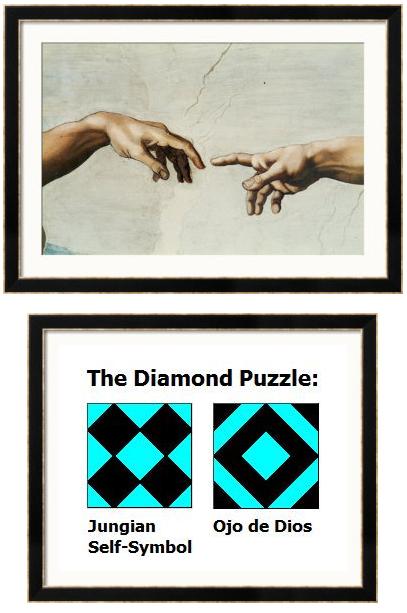
Log24 on Thursday, July 30, 2009Annals of Aesthetics, continued: Academy Awards “First of all, I’d like “A poem cannot exhaust reality, — At War with the Word: |
— Quoted here July 29, 2009
(the day the keeper of
the Oscars died)
Possible clues:
From Google News at about
7 AM ET Mon., Aug. 3, 2009:
Henry Louis Gates Jr. mulls moving over death threatsBoston Herald – – 6 hours ago
CHILMARK – Black scholar Henry Louis Gates Jr. has received numerous death threats since he accused a white officer of …
Death threats may make Gates moveThe Daily Inquirer – 4 hours ago
Henry Louis Gates Jr. said yesterday that Harvard University suggested he move after receiving numerous death threats since he accused a white officer of …
Gates: I’ve received death threatsNECN – 9 hours ago
… Gates spoke at a book signing on Martha’s Vineyard. He also said that he has received death and bomb threats after the incident at his Cambridge home. …
Black scholar says he’s able to joke about arrestThe Associated Press – – 17 hours ago
Gates said he received numerous threats after the incident, including an e-mail that read, “You should die, you’re a racist.” Gates has changed his e-mail …
Gates grateful for island havenCape Cod Times – – 4 hours ago
As a result of death threats and bomb threats, he hasn’t returned to his Cambridge home, leased from Harvard University. The university has encouraged him …
Gates makes public appearance after race debateWorcester Telegram – – 20 hours ago
Gates, who spoke at a book signing on Martha’s Vineyard Sunday, says there also have been some serious moments. He says he received death and bomb threats …
|
Friday, January 23, 2009
Friday January 23, 2009
Mathematics:
Happy Hilbert’s Birthday.
Today is the birthday
of mathematician
David Hilbert (1862-1943).
Narrative:
See a different Hilbert– namely Jules, a fictional professor of literary theory at the University of Illinois at Chicago played by Dustin Hoffman in “Stranger than Fiction” (cf. yesterday’s entry). See also, in today’s previous entry, Stanley Fish– a non-fictional literary theorist and former dean at the same institution.
Related material:
“The Gift in ‘Stranger than Fiction’,” by Eric Austin Lee (June 1, 2007).
Lee’s essay might please another mathematician whose name appears in the film. The clever but heartless Professor Hilbert is opposed, indirectly, in “Stranger than Fiction” by a Harvard Law dropout, Ana, who dispenses eucharistic blessings, in the form of cookies, at her Chicago bakery/café– filmed at a real Chicago location, Catedral Café. Her last name is Pascal.
Tuesday, January 6, 2009
Tuesday January 6, 2009
and Dyson on Jung
The current (Feb. 2009) Notices of the American Mathematical Society has a written version of Freeman Dyson's 2008 Einstein Lecture, which was to have been given in October but had to be canceled. Dyson paraphrases a mathematician on Carl Jung's theory of archetypes:
"… we do not need to accept Jung’s theory as true in order to find it illuminating."
The same is true of Jung's remarks on synchronicity.
For example —
Yesterday's entry, "A Wealth of Algebraic Structure," lists two articles– each, as it happens, related to Jung's four-diamond figure from Aion as well as to my own Notes on Finite Geometry. The articles were placed online recently by Cambridge University Press on the following dates:
R. T. Curtis's 1974 article defining his Miracle Octad Generator (MOG) was published online on Oct. 24, 2008.
Curtis's 1987 article on geometry and algebraic structure in the MOG was published online on Dec. 19, 2008.
On these dates, the entries in this journal discussed…
Oct. 24:
Cube Space, 1984-2003
Material related to that entry:
Dec. 19:
Art and Religion: Inside the White Cube
That entry discusses a book by Mark C. Taylor:
The Picture in Question: Mark Tansey and the Ends of Representation (U. of Chicago Press, 1999).
"What, then, is a frame, and what is frame work?"
One possible answer —
Hermann Weyl on the relativity problem in the context of the 4×4 "frame of reference" found in the above Cambridge University Press articles.
windows of knowledge."
— Vladimir Nabokov
Friday, December 19, 2008
Friday December 19, 2008
White Cube
Part I: The White Cube

Part II: Inside
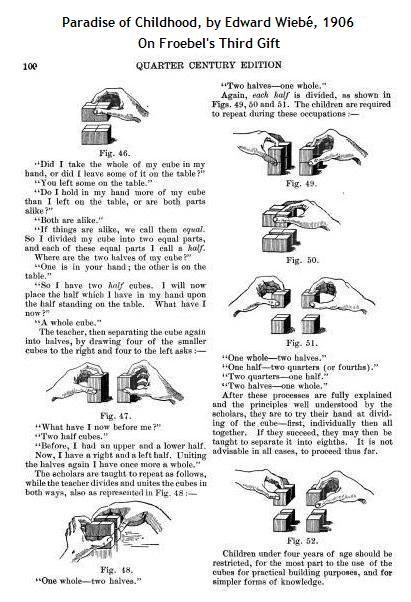
Part III: Outside
For remarks on religion
related to the above, see
Log24 on the Garden of Eden
and also Mark C. Taylor,
"What Derrida Really Meant"
(New York Times, Oct. 14, 2004).
For some background on Taylor,
see Wikipedia. Taylor, Chairman
of the Department of Religion at
Columbia University, has a
1973 doctorate in religion from
Harvard University. His opinion
of Derrida indicates that his
sympathies lie more with
the serpent than with the angel
in the Tansey picture above.
For some remarks by Taylor on
the art of Tansey relevant to the
structure of the white cube
(Part I above), see Taylor's
The Picture in Question:
Mark Tansey and the
Ends of Representation
(U. of Chicago Press, 1999):
|
From Chapter 3,
"Sutures* of Structures," p. 58: "What, then, is a frame, and what is frame work? This question is deceptive in its simplicity. A frame is, of course, 'a basic skeletal structure designed to give shape or support' (American Heritage Dictionary)…. when the frame is in question, it is difficult to determine what is inside and what is outside. Rather than being on one side or the other, the frame is neither inside nor outside. Where, then, Derrida queries, 'does the frame take place….'" * P. 61:
|
Sunday, December 7, 2008
Sunday December 7, 2008
the Soul
On a book by Margaret Wertheim:
“She traces the history of space beginning with the cosmology of Dante. Her journey continues through the historical foundations of celestial space, relativistic space, hyperspace, and, finally, cyberspace.” –Joe J. Accardi, Northeastern Illinois Univ. Lib., Chicago, in Library Journal, 1999 (quoted at Amazon.com)
There are also other sorts of space.

fom the Inventing Kindergarten
exhibit at The Institute for Figuring
(co-founded by Margaret Wertheim)
This photo may serve as an
introduction to a different
sort of space.
See The Eightfold Cube.
For the religious meaning
of this small space, see
the eight I Ching trigrams.
For a related larger space,
see the entry and links of
St. Augustine’s Day, 2006.
Saturday, December 6, 2008
Saturday December 6, 2008
Another Show
A footprint from Germany:
|
Germany Python-urllib |
/504856559/item.html |
12/6/2008 1:21 PM |
The link in the above footprint leads
to an entry of July 5, 2006.
The access method:
The urllib Module
|
For more pictures and discussion
of the object fetched by Python,
see AntiChristmas 2007.
For a larger and more sophisticated
relative of that object,
see Solomon's Cube and
the related three presents
from the German link's target:

|
1. Many Dimensions 2. Boggle 3. My Space |
Friday, November 14, 2008
Friday November 14, 2008
Riverrun
(The first word in Finnegans Wake.
See also the Log24 entries following
the death of Pope John Paul II.)
At Inside Higher Ed, Margaret Soltan ("UD") discusses…
"moments of clarity [cf. related essay (pdf)] that seem, when you look at all of them together late in the day, to disclose our life’s otherwise hidden pattern, meaning, and flow.
'Not far downstream was a dry channel where the river had run once, and part of the way to come to know a thing is through its death. But years ago I had known the river when it flowed through this now dry channel, so I could enliven its stony remains with the waters of memory. In death it had its pattern, and we can only hope for as much.'"
— A River Runs Through It, by Norman Maclean, a story about trout fishing and grace
Related material:
Maclean's fellow author Kilgore Trout and the story he is said to be most proud of, about Bunker Bingo.
See also yesterday's entry, Bob's Country Bunker, and On Linguistic Creation.
Saturday, November 8, 2008
Saturday November 8, 2008
 ET SUPER HANC PETRAM
ET SUPER HANC PETRAMAEDIFICABO ECCLESIAM
MEAM ET PORTAE INFERI
NON PRAEVALEBUNT
ADVERSUS EAM
Benedict XVI, before he became Pope:
“… a purely harmonious concept of beauty is not enough…. Apollo, who for Plato’s Socrates was ‘the God’ and the guarantor of unruffled beauty as ‘the truly divine’ is absolutely no longer sufficient.”
“The lapis manalis (Latin: ‘stone of the Manes‘) was a name given to two sacred stones used in the Roman religion. One covered a gate to Hades, abode of the dead….
One such stone covered the mundus Cereris, a pit thought to contain an entrance to the underworld….
The… mundus was located in the Comitium, on the Palatine Hill. This stone was ceremonially opened three times a year, during which spirits of the blessed dead (the Manes) were able to commune with the living. The three days upon which the mundus was opened were August 24, October 5, and November 8. Fruits of the harvest were offered to the dead at this time.”
Log24 on
August 24,
October 5, and
November 8.
Friday, June 20, 2008
Friday June 20, 2008
who died on Tuesday, June 17, 2008
"A man walks down the street…" — Paul Simon, Graceland album

Related material:
In the above screenshot of New York Times obituaries on the date of Brewster Beach's death, Tim Russert seems to be looking at the obituary of Air Force Academy chapel architect Walter Netsch. This suggests another chapel, more closely related to my own experience, in Cuernavaca, Mexico. Some background… Walter Netsch in Oral History (pdf, 467 pp.):
"I also had a book that inspired me– this is 1947– called Communitas by Percival and Paul Goodman. Percival Goodman was the architect, and Paul Goodman was the writer and leftist. And this came out of the University of Chicago– part of the leftist bit of the University of Chicago…. I had sort of in the back of my mind, Communitas appeared from my subconscious of the new town out of town, and there were other people who knew of it…."
"God As Trauma" by Brewster Yale Beach:
"The problem of crucifixion is the beginning of individuation."
"Si me de veras quieres, deja me en paz."
— Lucero Hernandez, Cuernavaca, 1962
A more impersonal approach to my own drunkard's walk (Cuernavaca, 1962,
after reading the above words): Cognitive Blending and the Two Cultures
An approach from the culture (more precisely, the alternate religion) of Scientism–
The Drunkard's Walk: How Randomness Rules Our Lives— is sketched
in Today's Sermon: The Holy Trinity vs. The New York Times (Sunday, June 8, 2008).
The Times illustrated its review of The Drunkard's Walk with facetious drawings
by Jessica Hagy, who uses Venn diagrams to make cynical jokes.
A less cynical use of a Venn diagram:

Thursday, June 12, 2008
Thursday June 12, 2008

“The scientific mind does not so much
provide the right answers as
ask the right questions.”
(The Raw and the Cooked,
1964, English translation 1969 —
paperback, U. of Chicago Press,
1983, “Overture,” p. 7)

Context of the question:
A Venn diagram —
shown here last Sunday —
by the illustrator of last Sunday’s
New York Times review of
The Drunkard’s Walk:
How Randomness
Rules Our Lives
Well, do you?

Related material:
6/10
(San Francisco’s new
Contemporary Jewish Museum
as a vision of Hell)
9/28
(A less theological,
more personal, discussion
of Venn diagrams)
Wednesday, July 25, 2007
Wednesday July 25, 2007
George Tabori
Filed with The New York Times
at 11:16 p.m. ET July 24, 2007–
George Tabori
“BERLIN (AP) — Hungarian-born playwright and director George Tabori, a legend in Germany’s postwar theater world whose avant-garde works confronted anti-Semitism, died Monday [July 23, 2007]. He was 93.
Tabori, who as recently as three years ago dreamed of returning to stage to play the title role in Shakespeare’s ‘King Lear,’ died in his apartment near the theater, the Berliner Ensemble said Tuesday, noting that friends and family had accompanied him through his final days. No cause of death was given.
Born into a Jewish family in Budapest on May 24, 1914, Tabori fled in 1936 to London, where he started working for the British Broadcasting Corp., and became a British citizen. His father, and other members of his family, were killed at Auschwitz.
Tabori moved to Hollywood in the 1950s, where he worked as a scriptwriter, most notably co-writing the script for Alfred Hitchcock’s 1953 film, ‘I Confess.’
He moved to Germany in the 1970s and launched a theater career that spanned from acting to directing to writing. He used sharp wit and humor in his plays to examine the relationship between Germany and the Jews, as well as attack anti-Semitism.
Among his best-known works are ‘Mein Kampf,’ set in the Viennese hostel where Adolf Hitler lived from 1910-1913, and the ‘Goldberg Variations,’ both dark farces that poke fun at the Nazis.”
From Year of Jewish Culture:
“The year 2006 marks the 100th anniversary of the establishment of the Jewish Museum in Prague.”
From the related page Programme (October-December):
“Divadlo v Dlouhé
George Tabori: GOLDBERGOVSKÉ VARIACE / THE GOLDBERG VARIATIONS, 19 October, 7 p.m. A comedy on creation and martyrdom.”
|
From Log24 on the date of 
The above is from Variable Resolution 4–k Meshes: Concepts and Applications (pdf), by Luiz Velho and Jonas Gomes. See also Symmetry Framed |
|
Theme (Plato, Meno)
 Click on “variations” above |
Thursday, July 5, 2007
Thursday July 5, 2007
“Although it may not at first be obvious,
the substitution for real religions
of a religion drained of particulars
is of a piece with the desire to
exorcise postmodernism.”
The previous entry linked to an entry of June 2002 that attacked the nominalism of Stanley Fish. Here is another such attack:
| From “Stanley Fish: The Critic as Sophist,” by R.V. Young, in Modern Age, June 22, 2003:
In one of the definitive works of conservatism in the twentieth century, Richard Weaver designates the rise of nominalism as a critical turn in the emergence of the intellectual and cultural disintegration associated with liberalism, which it is the business of a reviving conservatism to contest: “The defeat of logical realism in the great medieval debate was the crucial event in the history of Western culture; from this flowed those acts which issue now in modern decadence.” It is nominalism that provides the intellectual foundation– if a paradox may be hazarded– for the attack by Fish and numerous others (their name is Legion) on the very idea of intellectual foundations:
(4). Ideas Have Consequences (Chicago and London, 1948), 3. R.V. YOUNG is Professor of English at North Carolina State University and author of At War With the Word and Doctrine and Devotion in Seventeenth-Century Poetry (2000). |
Simon Blackburn on
Plato and sophists,
realism and nominalism
(previous entry)
Tuesday, May 8, 2007
Tuesday May 8, 2007
Symbology:
“Also known as ‘processual symbolic analysis,’ this concept was developed by Victor Turner in the mid-1970s to refer to the use of symbols within cultural contexts, in particular ritual. In anthropology, symbology originated as part of Victor Turner’s concept of ‘comparative symbology.’ Turner (1920-1983) was professor of Anthropology at Cornell University, the University of Chicago, and finally he was Professor of Anthropology and Religion at the University of Virginia.” —Wikipedia
Symbology and Communitas:
|
From Beth Barrie’s
“Victor Turner“— “‘The positional meaning of a symbol derives from its relationship to other symbols in a totality, a Gestalt, whose elements acquire their significance from the system as a whole’ (Turner, 1967:51). Turner considered himself a comparative symbologist, which suggests he valued his contributions to the study of ritual symbols. It is in the closely related study of ritual processes that he had the most impact.
The most important contribution Turner made to the field of anthropology is his work on liminality and communitas. Believing the liminal stage to be of ‘crucial importance’ in the ritual process, Turner explored the idea of liminality more seriously than other anthropologists of his day. As noted earlier Turner elaborated on van Gennep’s concept of liminality in rites of passage. Liminality is a state of being in between phases. In a rite of passage the individual in the liminal phase is neither a member of the group she previously belonged to nor is she a member of the group she will belong to upon the completion of the rite. The most obvious example is the teenager who is neither an adult nor a child. ‘Liminal entities are neither here nor there; they are betwixt and between the positions assigned and arrayed by law, custom, convention, and ceremonial’ (Turner, 1969:95). Turner extended the liminal concept to modern societies in his study of liminoid phenomena in western society. He pointed out the similarities between the ‘leisure genres of art and entertainment in complex industrial societies and the rituals and myths of archaic, tribal and early agrarian cultures’ (1977:43). Closely associated to liminality is communitas which describes a society during a liminal period that is ‘unstructured or rudimentarily structured [with] a relatively undifferentiated comitatus, community, or even communion of equal individuals who submit together to the general authority of the ritual elders’ (Turner, 1969:96). The notion of communitas is enhanced by Turner’s concept of anti-structure. In the following passage Turner clarifies the ideas of liminal, communitas and anti-structure:
It is the potential of an anti-structured liminal person or liminal society (i.e., communitas) that makes Turner’s ideas so engaging. People or societies in a liminal phase are a ‘kind of institutional capsule or pocket which contains the germ of future social developments, of societal change’ (Turner, 1982:45). Turner’s ideas on liminality and communitas have provided scholars with language to describe the state in which societal change takes place.”
Turner, V. (1967). The forest of symbols: Aspects of Ndembu ritual. Ithaca, NY: Cornell University Press. Turner, V. (1969). The ritual process: structure and anti-structure. Chicago: Aldine Publishing Co. Turner, V. (1977). Variations of the theme of liminality. In Secular ritual. Ed. S. Moore & B. Myerhoff. Assen: Van Gorcum, 36-52. Turner, V. (1982). From ritual to theater: The human seriousness of play. New York: PAJ Publications. |
Related material on Turner in Log24:
Aug. 27, 2006 and Aug. 30, 2006. For further context, see archive of Aug. 19-31, 2006.
Related material on Cuernavaca:
Google search on Cuernavaca + Log24.
Friday, May 4, 2007
Friday May 4, 2007
May '68 Revisited
"At his final Paris campaign rally… Mr. Sarkozy declared himself the candidate of the 'silent majority,' tired of a 'moral crisis in France not seen since the time of Joan of Arc.'
'I want to turn the page on May 1968,' he said of the student protests cum social revolution that rocked France almost four decades ago.
'The heirs of May '68 have imposed the idea that everything has the same worth, that there is no difference between good and evil, no difference between the true and the false, between the beautiful and the ugly and that the victim counts for less than the delinquent.'
Denouncing the eradication of 'values and hierarchy,' Mr. Sarkozy accused the Left of being the true heirs and perpetuators of the ideology of 1968."
— Emma-Kate Symons, Paris, May 1, 2007, in The Australian
Related material:
From the translator's introduction to Dissemination, by Jacques Derrida, translated by Barbara Johnson, University of Chicago Press, 1981, page xxxi —
"Both Numbers and 'Dissemination' are attempts to enact rather than simply state the theoretical upheavals produced in the course of a radical reevaluation of the nature and function of writing undertaken by Derrida, Sollers, Roland Barthes, Julia Kristeva and other contributors to the journal Tel Quel in the late 1960s. Ideological and political as well as literary and critical, the Tel Quel program attempted to push to their utmost limits the theoretical revolutions wrought by Marx, Freud, Nietzsche, Mallarme, Levi-Strauss, Saussure, and Heidegger."
This is the same Barbara Johnson who has served as the Frederic Wertham Professor of Law and Psychiatry in Society at Harvard.
Johnson has attacked "the very essence of Logic"–
"… the logic of binary opposition, the principle of non-contradiction, often thought of as the very essence of Logic as such….
Now, my understanding of what is most radical in deconstruction is precisely that it questions this basic logic of binary opposition….
Instead of a simple 'either/or' structure, deconstruction attempts to elaborate a discourse that says neither 'either/or', nor 'both/and' nor even 'neither/nor', while at the same time not totally abandoning these logics either."
— "Nothing Fails Like Success," SCE Reports 8, 1980
Such contempt for logic has resulted, for instance, in the following passage, quoted approvingly on page 342 of Johnson's translation of Dissemination, from Philippe Sollers's Nombres (1966):
"The minimum number of rows– lines or columns– that contain all the zeros in a matrix is equal to the maximum number of zeros located in any individual line or column."
For a correction of Sollers's Johnson's damned nonsense, click here.
Update of May 29, 2014:
The error, as noted above, was not Sollers's, but Johnson's.
See also the post of May 29, 2014 titled 'Lost in Translation.'
Wednesday, April 11, 2007
Wednesday April 11, 2007
Being Green

Don Imus, 1974 album
Rutgers women’s basketball
coach C. Vivian Stringer:
“It’s about us as people– black, white, purple or green. And as much as I speak about that, it’s not even black and white– the color is green.”
Imus flap about
black, white, and green
David Lieberman, Laura Petrecca and Gary Strauss in USA Today:
“So amid all the uproar over Imus’ remarks and the national discussion over race relations that they ignited, why wasn’t he fired?
Stringer and others think that has less to do with relations between blacks and whites than it does with another color.
‘The color is green– if we can tolerate as a society what’s just taken place,’ she said. ‘I don’t know how anyone could have heard this and not been offended.’
As one of the country’s most popular radio talk show hosts, Imus is the centerpiece of a multimillion-dollar business that would collapse without him.
To get a sense of its size: Advertisers spent $11.3 million last year on his show at just one station, New York’s WFAN, according to Nielsen. That accounted for nearly 24% of all the station’s ad sales.
Sponsors paid MSNBC an additional $8.4 million last year for spots on Imus’ show, according to TNS Media Intelligence.”
Mike Lupica in the
New York Daily News,
April 11, 2007:
“Essence Carson talked about what Imus had said about her and her teammates, and about everything that has happened since.
‘It has stolen a moment of pure grace from us,’ she said.
The moment of pure grace was Essence Carson….”
From ESSENCE.com:
“Essence Communications Inc. (ECI) was founded in 1968. In October 2000, ECI signed an agreement with Time Inc., a subsidiary of Time Warner Inc., to form a joint venture known as Essence Communications Partners. ESSENCE was the majority owner of the venture. In March 2005, Time Inc. acquired the portion it did not already own. The company’s name changed back to Essence Communications Inc. The ECI corporate headquarters are in New York City, with offices in Chicago, Los Angeles, Atlanta and Detroit.

ESSENCE magazine
During the past 36 years, the company has grown into a vital business of diverse media properties and communications systems that include ESSENCE, its flagship magazine launched in 1970. Its success is linked to its unique relationship with the readers of ESSENCE magazine and the strong alliances it has forged with America’s leading corporations and financial institutions.”
Thursday, March 8, 2007
Thursday March 8, 2007
Mujer Trabajadora

“Yo es que nací un 8 de marzo,
Día de la Mujer Trabajadora,
y no he hecho más que
trabajar toda mi vida.”
For background on Aldecoa,
see a paper (pdf) by
Sara Brenneis:
“Josefina Aldecoa intertwines
history, collective memory
and individual testimony in her
historical memory trilogy…”
The Triangle Shirtwaist Factory Fire in New York City on March 25, 1911, was the largest industrial disaster in the history of the city of New York, causing the death of 146 garment workers who either died in the fire or jumped to their deaths.
Propaganda, March 1977:
“On March 8, 1908, after the death of 128 women trapped in a fire at the Triangle Shirtwaist Factory in New York City, 15,000 women workers from the garment and textile industry marched echoing the demands of their sisters 50 years earlier…”
Propaganda, March 2006:
“First of all, on March 8th, 1857, a large number of factory workers in the United States took to the streets to demand their economic and political rights. The owners called the police who arrived immediately and opened fire, engaging in blind repression… Later on, in 1908, the same date of March 8th was once again a memorable date of struggle. On this day, capitalist bosses in Chicago set fire to a textile factory where over a thousand women worked. A very large number was terribly burnt. 120 died!”
Propaganda disguised as news, March 2007:
From today’s top story in 24 HoursTM, a commuter daily in Vancouver published by Sun Media Corporation:
Fight still on for equality
By Robyn Stubbs and Carly Krug
“International Women’s Day commemorates a march by female garment workers protesting low wages, 12-hour workdays and bad working conditions in New York City on March 8, 1857.
Then in 1908, after 128 women were trapped and killed in a fire at a New York City garment and textile factory, 15,000 women workers again took their protests to the street.”
Related historical fiction:
A version of the
I Ching’s Hexagram 19:
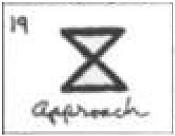

— Katherine Neville, The Eight
|
“What does this have to do with why we’re here?”
“I saw it in a chess book Mordecai showed me. The most ancient chess service ever discovered was found at the palace of King Minos on Crete– the place where the famous Labyrinth was built, named after this sacred axe. The chess service dates to 2000 B.C. It was made of gold and silver and jewels…. And in the center was carved a labrys.” … “But I thought chess wasn’t even invented until six or seven hundred A.D.,” I added. “They always say it came from Persia or India. How could this Minoan chess service be so old?” “Mordecai’s written a lot himself on the history of chess,” said Lily…. “He thinks that chess set in Crete was designed by the same guy who built the Labyrinth– the sculptor Daedalus….” Now things were beginning to click into place…. “Why was this axe carved on the chessboard?” I asked Lily, knowing the answer in my heart before she spoke. “What did Mordecai say was the connection?”…. “That’s what it’s all about,” she said quietly. “To kill the King.” The sacred axe was used to kill the King. The ritual had been the same since the beginning of time. The game of chess was merely a reenactment. Why hadn’t I recognized it before? |
Perhaps at the center of
Aldecoa’s labyrinth lurk the
capitalist bosses from Chicago
who, some say, set fire
to a textile factory
on this date in 1908.
For a Freudian perspective
on the above passage,
see yesterday’s entry
In the Labyrinth of Time,
with its link to
John Irwin‘s essay
“The False Artaxerxes:
Borges and the
Dream of Chess.”

Symbols
S. H. Cullinane
March 7, 2007
Today, by the way, is the
feast of a chess saint.
Friday, March 2, 2007
Friday March 2, 2007
Jennifer Jones,
film star and arts patron;
Tom Wolfe, author of
The Painted Word.
"Hunt for the best."
— Norton Simon

Cover detail,
soundtrack recording
of the Jennifer Jones film
"Angel, Angel, Down We Go"
The girl's left eye in the above
portrait illustrates a remark
in yesterday's New York Times
on a figure in a painting:
(This remark, by Michael Kimmelman,
comes with a headline–
Lights! Darks! Action! Cut!
Maestro of Mise-en-Scène
— that seems to have been inspired
by Tom Wolfe's prose style.)
For further details, see
Barthes's Punctum,
by Michael Fried.
Monday, February 12, 2007
Monday February 12, 2007
(Illustrated)
“The communication
of the dead is tongued with fire
beyond the language of the living.”
— T. S. Eliot, Four Quartets

Photo by Mark J. Terrill / AP
Above: Christina Aguilera performs “It’s a Man’s Man’s Man’s World” in tribute to the late James Brown during the Grammy Awards in Los Angeles on Sunday, February 11, 2007.
This morning’s New York Times:
Coming of Age in a Changed World
CAMBRIDGE, Mass., Feb. 11– Recalling her coming of age as the only girl in a privileged, tradition-bound family in Virginia horse country, Drew Gilpin Faust, 59, has often spoken of her “continued confrontations” with her mother “about the requirements of what she usually called femininity.” Her mother, Catharine, she has said, told her repeatedly, “It’s a man’s world, sweetie, and the sooner you learn that the better off you’ll be.”….
… Asked Sunday whether her appointment signified the end of sex inequities at the university, Dr. Faust said: “Of course not. There is a lot of work still to be done, especially in the sciences.”
What would her mother, who never went to college and died in 1966, have to say about her appointment? “I’ve often thought about that,” she said. “I’ve had dialogues with my dead mother over the 40 years since she died.”
Then she added with a rueful smile, “I think in many ways that comment– ‘It’s a man’s world, sweetie’– was a bitter comment from a woman of a generation who didn’t have the kind of choices my generation of women had.”
“But it wouldn’t mean
nothin’ … nothin’ …
without a woman or a girl.”
— James Brown,
who died last year
on Christmas Day

Saturday, December 2, 2006
Saturday December 2, 2006
Venus at
St. Anne's,
continued
In honor of
the film "Bobby,"
now playing.
("Venus at St. Anne's"
is the title of the final
chapter of
the C. S. Lewis classic
That Hideous Strength.)
Symbol of Venus
and
Symbol of Plato
Related symbols:

Click on pictures
for details related tp
the Feast of St. Anne
(July 26).
"The best theology today,
in its repudiation of a
rhetorical religious idealism,
finds itself in agreement
with a recurrent note
in contemporary poetry….
We keep coming back
and coming back/
To the real: to the hotel
instead of the hymns/
That fall upon it
out of the wind. We seek/
… Nothing beyond reality.
Within it/
Everything,
the spirit’s alchemicana….
(From 'An Ordinary Evening
in New Haven,'
in The Collected Poems
of Wallace Stevens….)
… Not grim/
Reality, but reality grimly seen….
(Ibid.)"
— "The Church's
New Concern with the Arts,"
by Amos N. Wilder,
Hollis Professor
of Divinity, Emeritus,
at Harvard Divinity School,
in Christianity and Crisis,
February 18, 1957.
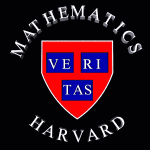 |
"All the truth in the world
adds up to one big lie."
Tuesday, November 28, 2006
Tuesday November 28, 2006
The reformation of the church in the 16th century brought changes to the Christmas markets. Nikolaus was replaced by the Christkindl (Christchild) as the gift giver and the Nikolaus markets became Christkindl markets. This custom began in the Protestant areas of Bavaria with Nuremberg being the first city to call its market Christkindlesmarkt. Munich, a Catholic city, changed its Nikolausdult to Christkindlmarkt in 1805.”
— Background for Christkindl Market in Kitchener, Ontario
This will also serve as background for today’s New York Times story on Chicago’s Christkindlmarkt:
“The Christkindl, the Christmas Fairy, is a cherished highlight during the Holiday Tree Lighting. The Christmas Fairy proclaims the opening of Christkindlmarket Chicago.”
Also from the official Chicago Christkindl website:
On the “Christkindl,” the Christmas Fairy & our sister-market visit
|
In its English version, the Nuremberg website calls the alleged “Christmas Fairy” an angel:
“The Nuremberg Christmas Angel with her white and golden dress, long blond curls and her golden crown, has been the symbol for the Christmas Market for many decades. During Advent time, the Christmas Angel is the most important representative of the city and of the traditional Christmas Market.
Every year, on the Friday before the first Advent Sunday, the Nuremberg Christmas Angel opens the Nuremberg Christmas Market by reciting a solemn prologue.”
The German version of the Nuremberg site calls the Christmas Angel the Christkind (Christ Child). This confusion of the Christ Child with a supernatural bringer of gifts– hence, later, an angel, and, in Chicago, a fairy– is said to have originated with Martin Luther.
From a Radio Deutsche Welle website–
The making of a myth
The Christkind was originally introduced in the 16th century by religious reformer Martin Luther. Until then, it was always Saint Nicholas who brought gifts on Dec. 6. But as Protestants can’t have saints, Luther needed a new Christmas tradition for his followers. “Luther wanted to move the gift-giving away from the Catholic holiday on Dec. 6,” said Nuremberg tourism manager Michael Weber. “So he reinvented the tradition for Protestants by moving it to Christmas Eve and making the Christkind— really, the baby Jesus– the person who brought the gifts.”
It was under the rule of the National Socialists that the image of today’s Christkind was ultimately anchored in the collective German mind. They built on Nuremberg’s tradition of producing tinsel angels, and in 1933, had a young girl in an angel costume open the city’s Christmas Market for the first time. After the second World War, Nuremberg’s tinsel angels became simply the Nuremberg Christkind, and the figures were sold nation-wide.
Here is the banner for the Nuremberg site:
The banner reads:
“Nuremberg Christkindlesmarkt–
Where the Christ Child
is at home“

Maybe.
Sunday, November 5, 2006
Sunday November 5, 2006
The Hermeneutics
of Chance
— Grover Smith, T.S. Eliot’s Poetry and Plays: A Study in Sources and Meaning. Chicago: University of Chicago Press, 1956
The Grail also appears in legend as a stone–
From a Nov. 6, 2006, entry in the New Zealand weblog Arcadian Functor:
They live from a Stone whose essence is most pure. If you have never heard of it I shall name it for you here. It is called Lapsit exillis.
A search on “lapsit exillis” leads to “Cubic Stones from the Sky“…
These stones are often seen as the Holy Grail….

8/04 —
The Presbyterian Exorcist
(in part a tribute to
Wallace Stevens).
For 008 and a
“cubic stone,”
see
Christmas 2005.
A poetic connection between the star
of “The Hollow Men” and Christmas
is furnished by the remarks of
Wallace Stevens linked to in
the previous entry from
the word “information.”
Tuesday, October 24, 2006
Tuesday October 24, 2006
of the previous entry's concept of
a "critical mass" of weblog entries,
a concept reflected in
the saying
"You can't win the lottery
if you don't buy a ticket."
Mathematics and Narrative:
A Two-Part Invention
Here are today's
numbers from the
Keystone State:

of those numbers:
The second sentence, in bold type, was added on 8/21 by yours truly. No deep learning or original thought was required to make this important improvement in the article; the sentence was simply copied from the then-current version of the article on Grigori Perelman (who has, it seems, proved the geometrization conjecture).
This may serve as an example of the "mathematics" part of the above phrase "Mathematics and Narrative" — a phrase which served, with associated links, as the Log24 entry for 8/21.
7/23 — Narrative:
This quotation appeared in the Log24 entry for 7/23, "Dance of the Numbers." What Dyson calls a "story" or "drama" is in fact mathematics. (Dyson calls the "steps" in the story "works of art," so it is clear that Dyson (a former student of G. H. Hardy) is discussing mathematical steps, not paragraphs in someone's account– perhaps a work of art, perhaps not– of mathematical history.) I personally regard the rhetorical trick of calling the steps leading to a mathematical result a "story" as contemptible vulgarization, but Dyson, as someone whose work (pdf) led to the particular result he is discussing, is entitled to dramatize it as he pleases.
For related material on mathematics, narrative, and vulgarization, click here.
The art of interpretation (applied above to a lottery) is relevant to narrative and perhaps also, in some sense, to the arts of mathematical research and exposition (if not to mathematics itself). This art is called hermeneutics.
For more on the subject, see the Stanford Encyclopedia of Philosophy article on Hans-Georg Gadamer, "the decisive figure in the development of twentieth-century hermeneutics."
"Foreword" in Gian-Carlo Rota,
Indiscrete Thoughts,
Boston: Birkhäuser Verlag,
1996, xiii-xvii, and
"Gadamer's Theory of Hermeneutics" in
The Philosophy of Hans-Georg Gadamer,
edited by Lewis E. Hahn,
The Library of Living Philosophers, Vol. 24,
Chicago: Open Court Publishers,
1997, 223-34.
Thursday, October 19, 2006
Thursday October 19, 2006
(continued from Sept. 5):

Thanks to Peter Woit’s weblog
for a link to the above illustration.
This picture of
“Coxeter Exhuming Geometry”
suggests the following comparison:

For the second tombstone,
see this morning’s entry,
Birth, Death, and Symmetry.
Further details on the geometry
underlying the second tombstone:

The above is from
Variable Resolution 4–k Meshes:
Concepts and Applications (pdf),
by Luiz Velho and Jonas Gomes.
See also Symmetry Framed
and The Garden of Cyrus.
| “That corpse you planted last year in your garden, Has it begun to sprout? Will it bloom this year? Or has the sudden frost disturbed its bed?” — T. S. Eliot, “The Waste Land“ |
Thursday October 19, 2006
(Born Oct. 19, 1605,
died Oct. 19, 1682)
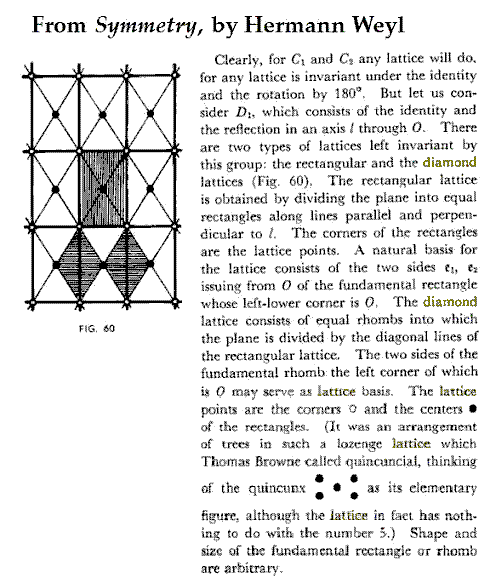
Browne is noted for
Hydriotaphia (Urne-Buriall)
and The Garden of Cyrus.
Related material:

Wednesday, August 30, 2006
Wednesday August 30, 2006
Seven
“Research & Ideas” memo from Harvard Business School dated April 17, 2006:
“The word experience comes from the Latin words ex pericolo, which mean ‘from danger.'”
— Etymology by Professor Joseph Badaracco of Harvard University. Badaracco gives no evidence for his dubious claim.
Related (if only temporally):
Easter Monday, April 17, 2006.
- experience
- 1377, from O.Fr. experience, from L. experientia “knowledge gained by repeated trials,” from experientem (nom. experiens), prp. of experiri “to try, test,” from ex- “out of” + peritus “experienced, tested.” The v. (1533) first meant “to test, try;” sense of “feel, undergo” first recorded 1588.
The title of this entry refers to the time it was posted. Related references to seven: April 7, 2003, and today’s previous entry.
See also an entry from 2/29, 2004
(Leap Day and Oscar Night):
|
Vita Brevis “In many ways, the arts are the highest achievements of man.” — Harvard President ”We intensively train children in the Arts and ritual because deep down we know that these are the only things that really MATTER. This is what we must share first with the young, in case they DIE.” — Lucy Ellmann, Dot in the Universe, quoted in today’s [2/29/04] New York Times |
Harvard persons from parts of the university that are more scholarly than the Business School may sneer at the above-quoted Online Etymology Dictionary. They can consult the following:
On “experience”
From
J.L. Austin,From Ritual to Theatre: The Human Seriousness of Play:“Scholars, such as Julius Pokorny (Indogermanisches Etymolgisches Worterbuch, 1959), trace ‘experience’ right back to hypothetical Indo-European base or root *per-, ‘to attempt, venture, risk,’ whence the Greek peira,”experience,” the source of our word ’empirical.’ It is also the verbal root which derives the Germanic *feraz, giving rise to Old English faer, “danger, sudden calamity,” whence Modern English ‘fear.’ Already, we see the ‘cognitive’ directions taken by * per-, through the Greek route, and affective ones, through the Germanic — which would have interested Dilthey, one may be sure! But more directly ‘experience’ derives, via Middle English and Old French, from the Latin experientia, denoting ‘trial, proof, experiment,’ itself generated from experiens, the present participle of experiri, ‘to try, test,’ from from ex-, ‘out’ + base per as in peritus, ‘experienced,’ ‘having learned by trying.’ The suffixed extended form of *per is peri-tlo-, whence the Latin periclum, periculum, “trial, danger, peril. Once more, we find experience linked with risk, straining towards ‘drama,’ crisis, rather than bland cognitive learning!”
“… Finally, ‘experiment,’ like ‘experience,’ is derived from Latin experiri “to try or test.” If we put these various senses together we have a ‘laminated’ semantic system focused on ‘experience,’ which portrays it as a journey, a test (of self, of suppositions about others), a ritual passage, an exposure to peril or risk, a source of fear. By means of experience, we ‘fare’ ‘fearfully’ through ‘perils,’ taking ‘experimental’ steps. …” (17-18)
The above is taken from an anonymous weblog entry. The author of the entry identified the source as From Ritual to Theatre: The Human Seriousness of Play. The author of the entry falsely stated that the author of this book was J. L. Austin. In fact, the book was written by Victor Turner, apparently the same philosophical sociologist whom we encountered in the previous entry and in the Log24 entry for the recent feast of St. Max Black. Turner may have been quoting Austin; pages from the book are not available online. Another author, however, says the quotation is by Turner himself. See Rena Fraden’s Imagining Medea, pp. 218-219.
Today’s previous entry is a sort of “ritual passage” for a Nobel Prize winner. For a ritual passage more directly related to Professor Badaracco, see the Brookline TAB obituary of his 23-year-old daughter, who died on Monday, August 21, 2006. According to today’s online Harvard Crimson, “she was walking along Hammond Street in Newton [Mass.] when an 84-year-old driver jumped the curb and struck her.”
From her Brookline TAB obituary of Thursday, Aug. 24, 2006:
“Funeral services will be held Friday [Aug. 25, 2006] at 10 a.m. at St. Mary’s of the Assumption Church, at 67 Harvard St.
The family asks that in lieu of flowers, donations be made to the Centro Romero Community Center in Chicago: 6216 N. Clark St., Chicago, IL 60660.”
Sunday, July 9, 2006
Sunday July 9, 2006
Today’s birthday:
Tom Hanks, star of
“The Da Vinci Code”
and the Holy Grail
Part I:
A Current Exhibit
Part III:
The Leonardo Connection
Part IV:
Nicholson’s Grail Quest
— Ben Nicholson in a 2005 interview
Nicholson’s quest has apparently lasted for some time. Promotional material for a 1996 Nicholson exhibit in Montreal says it “invites visitors of all ages to experience a contemporary architect’s search for order, meaning and logic in a world of art, science and mystery.” The title of that exhibit was “Uncovering Geometry.”
For web pages to which this same title might apply, see Quilt Geometry, Galois Geometry, and Finite Geometry of the Square and Cube.
* “Square Kufi” calligraphy is used in Islamic architectural ornament. I do not know what, if anything, is signified by Nicholson’s 6×12 example of “Kufi blocks” shown above.
Monday, April 10, 2006
Monday April 10, 2006
continued
Princeton calls Eating Clubs."
Illustrated below:
The Restaurant

Related etymology:
OF.
from L.
— Webster's Revised
Unabridged Dictionary, 1913
Related material:
(1) A symbol of symmetry
that might have pleased
Hermann Weyl:

Source —
Timothy A. Smith on
Bach's Fugue No. 21,
the Well-Tempered
Clavier, Book II
(pdf or Shockwave)
(2) The remarks of Noam D. Elkies
on his
"Brandenburg Concerto No. 7":
"It is of course an act of chutzpah,
some would say almost heresy,
to challenge Bach so explicitly
on his own turf."
(3) The five Log24 entries
culminating on Pi Day,
March 14, 2006
(4) The following event at the
Harvard University
mathematics department
on March 14, 2006, also
featuring Noam D. Elkies:
"At 3:14 p.m., six contestants began
a pie-eating contest…. Contestants had
exactly three minutes and 14 seconds
to eat as much pie as they could.
'Five, four, pi, three, two, one,'
Elkies counted down as the
contestants shoved the last
mouthful of pie
into their mouths…."
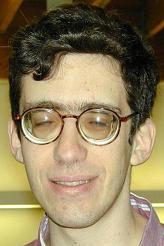
Noam D. Elkies
Tuesday, March 21, 2006
Tuesday March 21, 2006
“In a scathing attack on what they termed the ‘Israel Lobby,’ the Kennedy School’s Stephen M. Walt and the University of Chicago’s John J. Mearsheimer argued in a recent article that supporters of Israel have seized control of U.S. foreign policy, making it reflect Israel’s interests more than those of the U.S.”







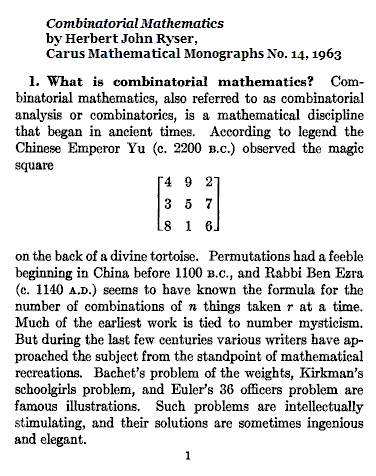




































































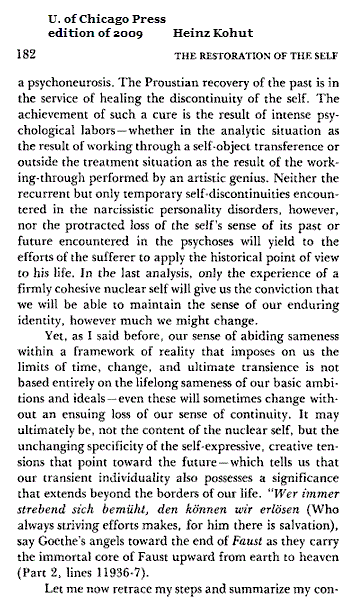







 .
.






